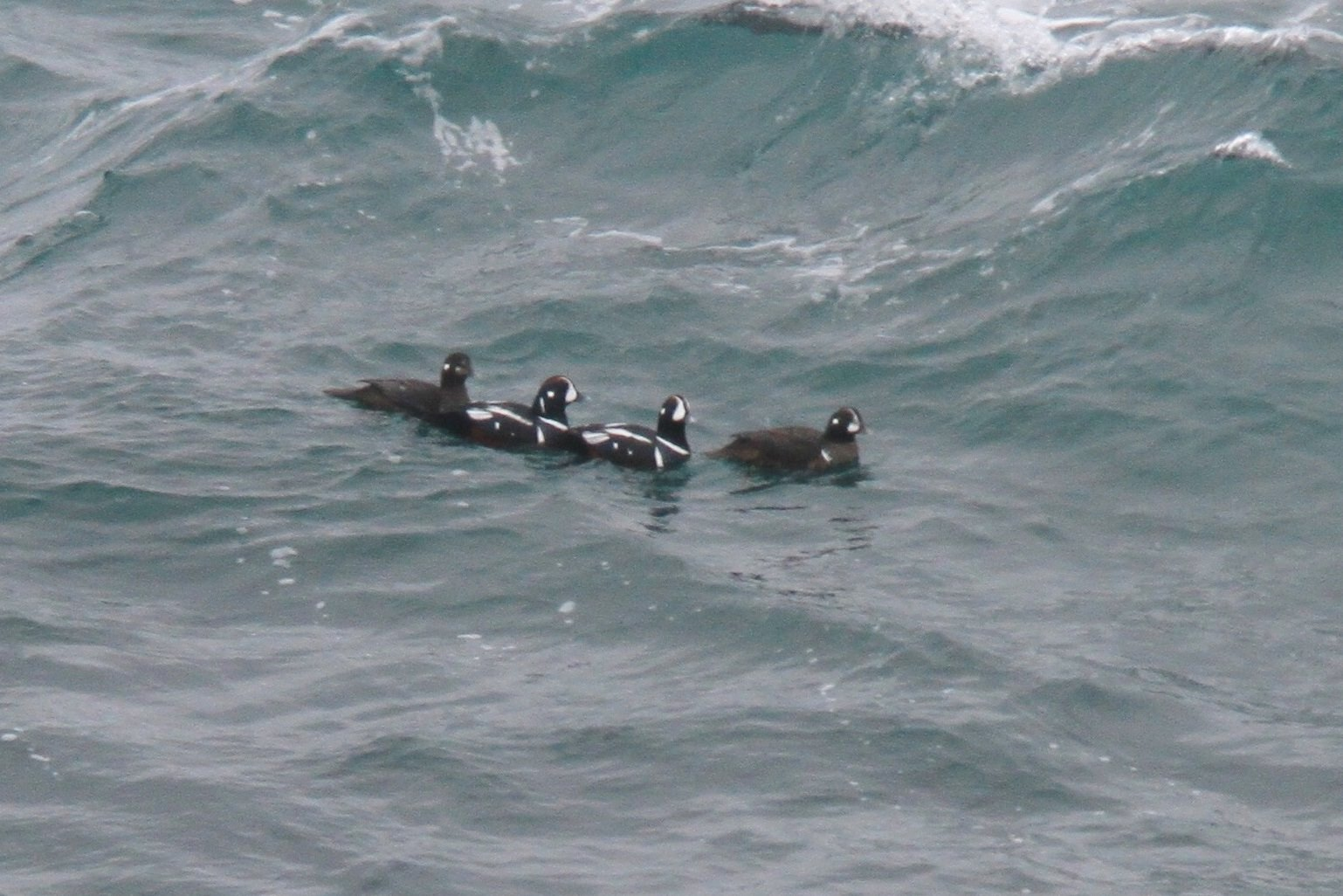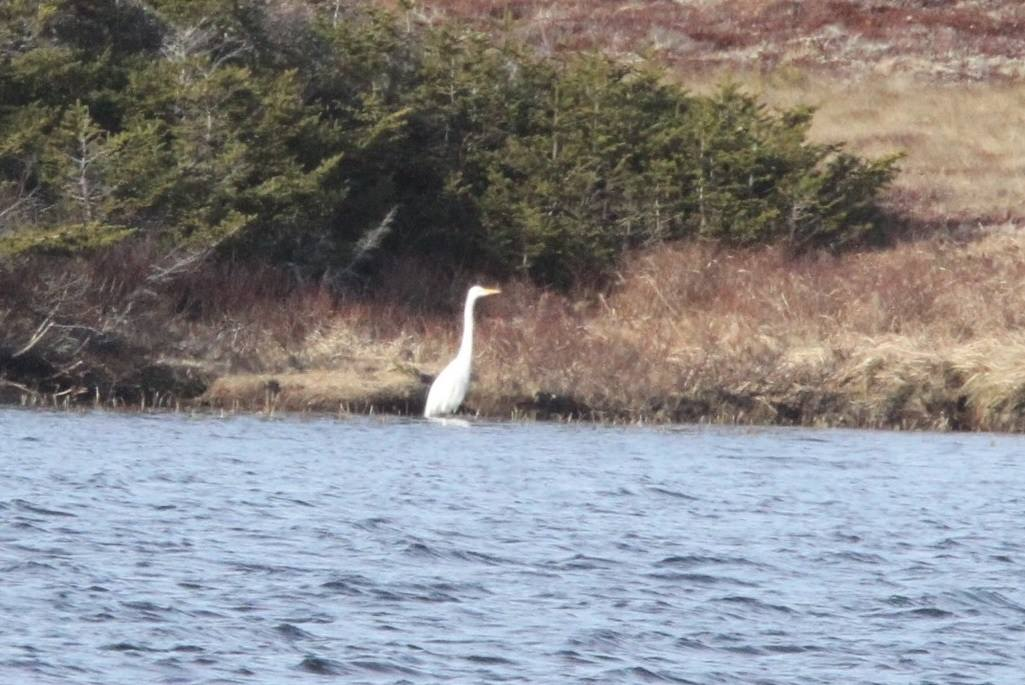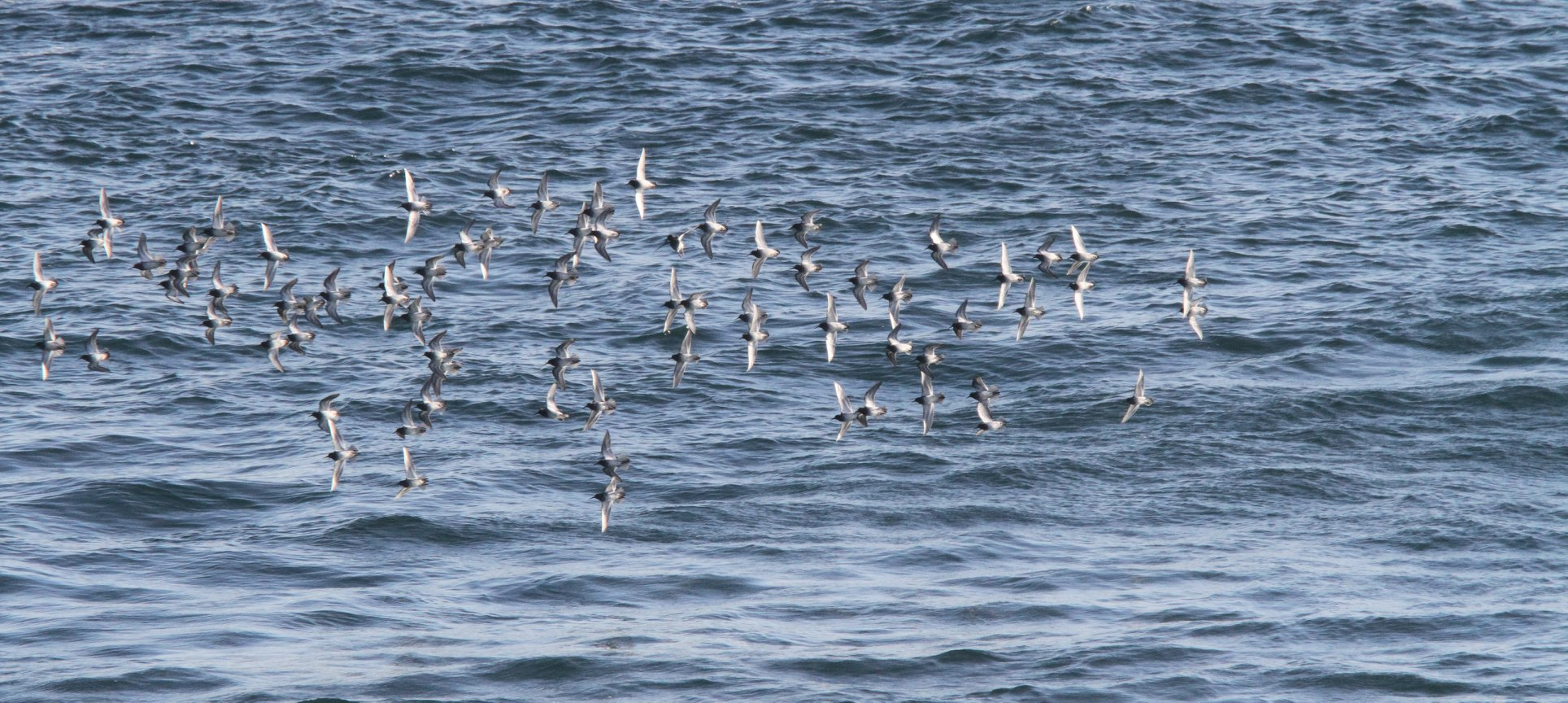Search
Four Season Birding in the Southeast Avalon
Spring: March 21 to June 20
Introduction
Readers, who examine this document, will find in the accompanying Checklist additional information on species discussed here. The Checklist breaks down individual species records by season. For example, for each species within the spring season it includes an assessment of relative rarity, number of records, dates and locations of observation.
The great diversity of climatic conditions between March and June can make spring birding surprisingly variable and rewarding. There is a lot to see highlighted by the ever-present resident boreal species, wintering arctic species which linger into spring, or pass through on their way north, and regular and irregular migrants from Europe and North America. Set out below are selected details of species that can be found in our area in Spring.
To capture the differences, the spring period has been divided into early and late. The boundary between the two is somewhat arbitrary largely due inter-seasonal variation.
Early Spring: March 21 to April 30
Main Highlights
- Harlequin Duck
- King Eider
- Great Cormorant
- Eurasian Golden-Plover
- Pomarine Jaeger
- Dovekie
- Purple Sandpiper
- First returning seabirds and land birds
Resident Land Birds
The regular presence of resident boreal species such as Willow Ptarmigan, Black-backed Woodpecker, Canada Jay, Boreal Chickadee, Pine Grosbeak, Purple Finch and Red and White-winged Crossbills provide an incentive for birders to venture into our area in this or any season.
Arctic Species
Our high northern latitude situated on the edge of the northwest Atlantic, provides a wintering refuge for numerous arctic species which arrive in late fall and linger into spring. One can get a snapshot of the variety and numbers of overwintering species by examining the database summary of records from the Cape Race Christmas Bird Count discussed in detail under Winter.
The following bird lists group the average spring migration dates for important overwintering arctic species which leave in early spring. Specific details on number, dates of departure and locations of recording for each species can be found on the Checklist.
Mid-March into late March:
- Dovekie
Late March
- King Eider
- Great Cormorant
- Snowy Owl
- Northern Shrike
- Snow Bunting
Mid-April
- Thick-billed Murre
- Horned Grebe
- Red-necked Grebe
- Red-throated Loon
- Glaucous Gull
- Iceland Gull
- Purple Sandpiper
- Bohemian Waxwing
Late April
- Common Eider
- Harlequin Duck
Due to variable weather conditions it is not uncommon to record some arctic species later in spring and occasionally into summer especially on the south coast. This is particularly the case with Common Eider, Great Cormorant, Red-throated Loon and Glaucous Gull. Rarely, a few other species have been known to linger and can occasionally be found into early summer including Dovekie, Snowy Owl, and Harlequin Duck.
Arctic Migrants in Passage
Some arctic species which winter in Atlantic waters to the south of Newfoundland regularly pass by the our coast in early spring on their way to arctic breeding grounds.
Jaegers usually winter in the mid-latitudes of the Atlantic Ocean. The Pomarine Jaeger is the most hardy as demonstrated by one individual recorded on the Cape Race Christmas Bird Count. The Pomarine is the jaeger species most likely to be recorded during early spring migration. They are thought to venture inshore on strong variable southern winds. One of the most interesting records of jaeger migration was the sighting of 25+ adult Pomarine Jaegers at PCS beach on April 25, 2012 and 25 at Peter’s River on April 27, 2018. There are a few other records. They can be looked for during their migration period which peaks in a very confined time period between April 25 and May 10.
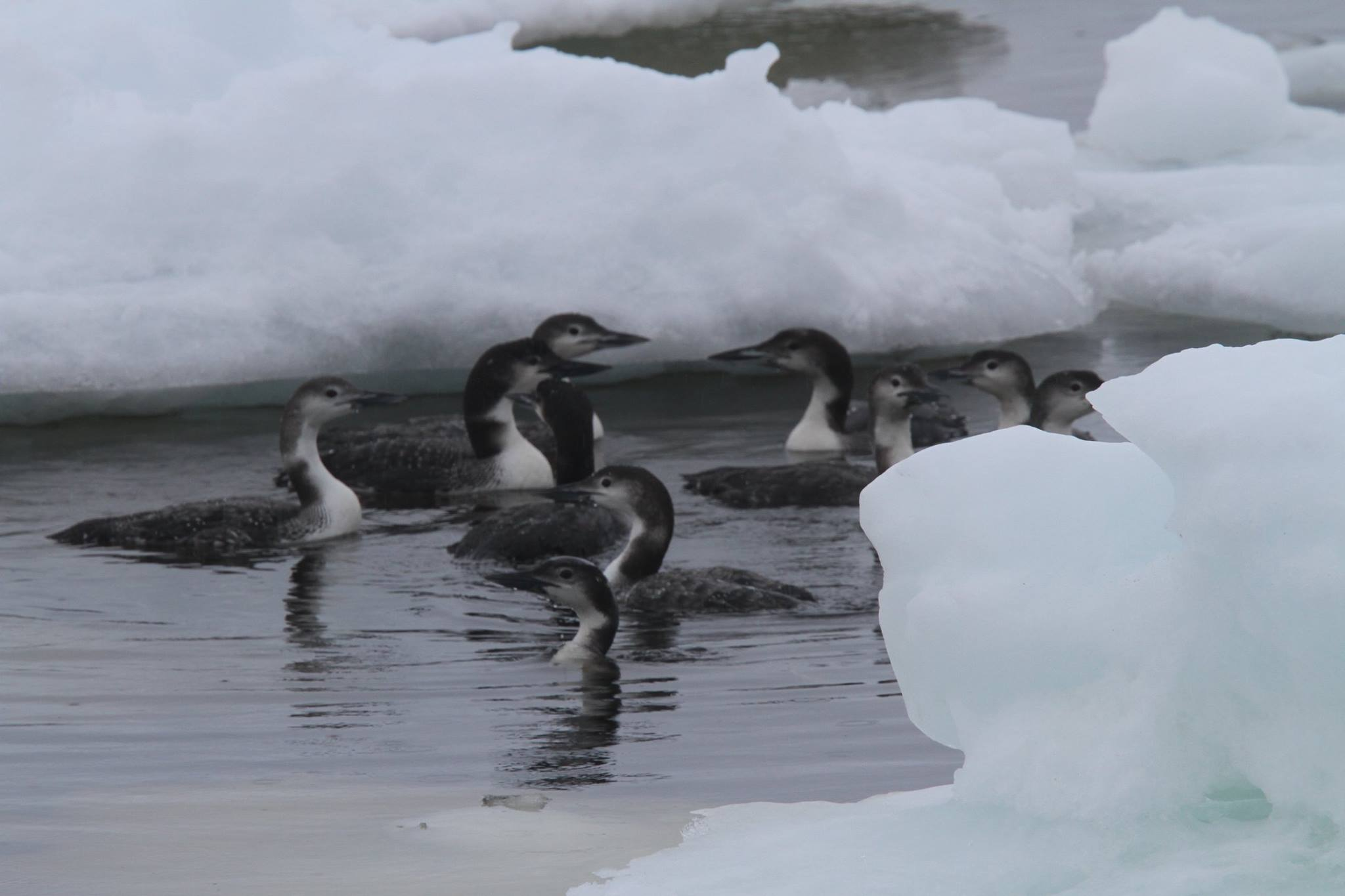 Winter-plumaged Common Loons can occasionally congregate, hemmed in by sea ice
Winter-plumaged Common Loons can occasionally congregate, hemmed in by sea ice
It has been discovered that species, such as the very rare, high arctic breeding, Yellow-billed Loon may occasionally winter offshore in mid-Atlantic waters. A single bird was recorded on in mid-April, 2017 with many hundreds of Common Loons in Trepassey harbour during a period when massive off-shore slob ice drove the loons inshore. Perhaps equally surprising are multiple-year winter records for Pacific Loon on the southern shore, one which lingered as late as June.
Early Returning Breeding Seabirds
Mid-March
Black-legged Kittiwakes remain offshore in winter migrating to inshore coastal areas by this time.
Mid-April
While a few alcids remain in Avalon coastal areas in winter, almost all Common Murres, Atlantic Puffins, Razorbills and Black Guillemots migrate offshore. Most return to their breeding colonies by mid-April. The Double-crested Cormorant returns to nest about the same time. This invasion of seabirds returning to nest on coastal cliffs and shores is a sure sign that winter is coming to an end.
Early Returning Breeding Land Birds
Mid-March
Canada Geese return at this time and in recent years other much rarer arctic-breeding geese. Regular nesting ducks such as the American Black Duck return at this time.
Early April
Dabbling ducks such as Northern Pintail and Green-winged Teal and diving ducks such as Greater Scaup and Ring-necked Duck have returned by this time. The ducks are joined by the first of the returning sparrows: Fox and Savannah.
Late April
A minor flood of local migrant breeding birds have returned by this time including: American Bittern, Greater Yellowlegs, Common Tern, Northern Goshawk, Northern Harrier, Short-eared Owl, White-throated, Song and Swamp Sparrows and Common Grackles. While the occasional warbler might show up on the Christmas Bird Count virtually none make it through the winter, The Yellow-rumped Warbler is likely to be the first migrant warbler, recorded by the end of April.
European Vagrants
The most reliable of Eurasian migrant is the Eurasian Golden Plover normally migrating to Iceland and Greenland but deflected off course by prevailing westerly winds. On average single birds or small numbers show up about mid-April especially along the east coast in places like Renews, Cappahayden and particularly on the southern shore at PCS and especially along the Cape Race Road and Cape Race. Sightings are frequent enough that birders specifically seek them out from early April. Very occasionally they can be found into early May.
The Northern Lapwing, while rare, is most likely to show up in late fall or winter. There are a few records in April and May as well.
There are a few Tufted Duck records from mid-April. These birds are most certainly strays from the regular Greenland birds that winter in the St. John’s area each year. Single European vagrants recorded in early spring include White Wagtail and Brambling, both recorded at Renews. There are multiple records for the Ruff from March and April but it is more likely to be encountered locally in May and occasionally into summer.
Atlantic Flyway Vagrants
The Great Egret is one of the few migrants from southern Atlantic coast regions which end up in the Avalon in early spring. They are usually found in local wetlands in March and April. There are also a few early spring records for Snowy Egret from mid-April, May and into June.
Late Spring: May 1 to June 20
By early May overwintering arctic species have usually migrated. However, arctic species which winter in the Atlantic Ocean further south pass through on their way to their northern breeding grounds. During this period European vagrants occasionally appear along with migrating North American species which overshoot. At this time the rest of the regular Newfoundland and Labrador migrant breeding species return.
Main Highlights
- Red Phalarope
- Red-necked Phalarope
- European Shorebirds
- Wheatear
- local nesting passerines
Resident Land Birds
As in the early spring, the regular presence of resident boreal species such as Willow Ptarmigan, Black-backed Woodpecker, Canada Jay, Boreal Chickadee, Pine Grosbeak, Purple Finch and Red and White-winged Crossbills provide an incentive for birders to venture into our area in this season.
Arctic Migrants in Passage
May 10 to June 10
This is a period when species of pelagic-wintering phalaropes, jaegers, and rare gulls have been recorded.
Red and Red-Necked Phalarope
A flock of breeding plumage pelagic phalaropes of either species in migration north to arctic waters is an event few birders can ever hope to see. In coastal Avalon, while phalarope encounters are rare, they regularly pass through each year during a two week period within the migrating window of May 15 to June. 10. Lots of interesting detail on these two species can be found on the Checklist.
Parasitic and Long-tailed Jaeger
While the bulk of the Pomarine Jaegers pass through earlier, all three species are more likely to be recorded during the same time frame as the phalaropes.
Mid-April into June
Arctic Gulls
Both Glaucous and Iceland Gulls which winter in the area can usually be found until mid-April. Records of other arctic gull records are rare. If an Ivory Gull has put in an appearance it would be in the winter. Do not expect one in spring. On the other hand there are records for Ross’s Gull, May 11 at Powles Head, and Sabine’s Gull, June 11 at Cape Race. There are two records of Little Gull in mid-June.
Late May and early June
Thick-billed Murre
The Thick-billed Murre does not nest locally but it is regular in winter on the Cape Race Christmas Count. By mid-April local seabirds have usually returned to their nesting colonies. Depending on where they winter offshore, sometimes many tens of thousands of murres migrate close enough to land to be seen in late May or early June. The identity of the murre species is uncertain but circumstantial evidence suggests strongly that these are high-arctic nesting Thick-billed Murres. Ebird data clearly shows that local Common Murres, which nest in large numbers on Great Island, Witless Bay, like other local seabirds, are in residence by mid-May. Coastal vantage points along the Cape Race Road and especially at Cape Race are the best places to look for these murres in late May-early June.
Pelagic Migration
Late spring is the beginning of the annual pelagic event which is a key feature of local summer birding. The vanguard of the Great and Sooty Shearwater migration from the southern hemisphere is usually under way in southern shore coastal waters by mid-June.
The Manx Shearwater is to be looked for from early June. Small colonies exist on Middle Lawn Island, Burin Peninsula, at Matinicus Island, Maine, and Penikese Island, Massachusetts. The Burin population is estimated at less than 100 pairs. Taking numerous years to mature enough to breed, he non-breeding population is suspected to be three or four times larger. As a result, with careful observation, you can expect to see a Manx or two from extreme southern shore vantage points such as Cape Race, Cape Pine and St. Shotts. Manx populations in Atlantic coastal waters have been increasing since at least the 1970s. This is likely due to increased water temperatures due to climate change. Other pelagics, discussed under the summer season, are less likely to be recorded at this time.
European Vagrants
The variable spring winds and weather can welcome an exceptional variety of migrating birds passing through or blown off course. The eastern Avalon is the first landfall for European spring migrants arriving after prevailing westerly winds.
During the month of May the Wheatear is to be looked for each year in coastal habitats. In 2001, after a particularly major Wheatear invasion, a pair remained to nest in a rock wall a few hundred metres north of Cape Pine lighthouse. The pair, which found the south coast barrens to their liking, successfully raised six young far from their home turf.
Local records for rare European species in late spring include the Eurasian Wigeon (May) but shorebirds are most likely: Black-tailed Godwit (late April to mid-June), Ruff (mostly in May) and single records for Common Redshank, (early May), Eurasian Whimbrel, (mid-May) and Curlew Sandpiper (mid-June). There is also a single record for Little Egret (late May to mid-June).
Atlantic Flyway Vagrants
The area is also a refuge for birds in the Atlantic flyway blown north and east of their regular breeding grounds.
The spring storms that rage along the Atlantic seaboard carry the first gulls of the season along with a smattering of herons and passerines north to the shores of the southeast Avalon where they make their final landfall. Tragically, the vast majority of the passerines are lost at sea and never recorded.
In recent years the non-breeding Laughing Gull has become a fairly regular feature of the south coast mostly recorded from mid-May to mid-June. In mid-May to late spring, storm-tossed herons have been recorded including Snowy Egret (mid-April into early June,), Glossy Ibis (May) and Little Blue and Tricoloured Herons (June). All are birds which normally breed in the mid-Atlantic or southern states. These birds are to be looked for in one of the key local coastal wetland sites: Renews harbour, the barachoises of Portugal Cove South and Biscay Bay, or the complex of wetlands in the Trepassey area which include Stadium Pond and Fannys Pond to the east of town, and Northwest Arm in Trepassey harbour.
Vagrant passerine migrants that overshoot their breeding territories, are few. Those recorded locally include Hooded Warbler (early May), Summer Tanager (late April and May), Rose-breasted Grosbeak (mid-April to mid-May) and Indigo Bunting (mid May to early June). The volume and variety of these non-breeding Newfoundland migrating species is a fraction of the vastly greater numbers and variety recorded in late summer and fall.
Western Canadian Vagrants
The main season for prairie and west coast vagrants, an outstanding feature of local birding, is also largely confined to the late summer and fall. Despite the obvious massive dislocation, the very few spring records are somewhat unique. They have been combined across the whole spring season:
- Black-necked Stilt, May 31 to June 7
- Western Kingbird, April 2
- Varied Thrush, May 1
- Western Meadowlark, May 31
- Brewer’s Blackbird, June 2-8
Late Returning Migrants
Regular gull and tern action heats up during this period. Both Black-headed and Lesser Black-backed Gulls, which do not currently breed in the area, can be found in April continuing into May, and in the case of the Black-headed, into June. See the Checklist for exact dates. Arctic Terns, long distance migrants, which nest on islands at the inner harbour at Renews and at Daniel’s Point, Northwest Arm, Trepassey, usually arrive by mid-May.
By early May local breeding seabirds are mostly back to their nesting colonies and birders are more likely to turn their attention to returning land birds. Returning during May are local breeding Least Sandpipers, Ruby-crowned Kinglets, American Robins and Hermit Thrushes and most species of warblers.
Late arriving species that show up in June include Mourning and Wilson’s Warblers and the Yellow-bellied Flycatcher,. Two of the more interesting species that do not breed locally are rare passage migrants in spring: Rusty Blackbird in early May, and Lincoln’s Sparrow in late May.
For more details on the many passerine migrants and breeding birds please refer to the Checklist. In addition, further details on some the more interesting nesting boreal species will be found in a special paper under summer entitled “Annotated List of Breeding Land Birds”.
Summer: June 21 to September 20
In order to highlight the unique diversity over the course of the summer, birding has been divided into two periods: June 21 to August 15 and August 16 to September 20. As noted in the discussion of the spring period, these boundaries are somewhat arbitrary and records can overlap. Additional details on all species discussed here will be found in the Checklist.
Early Summer: June 21 to August 15
Most of the local and out-of-province birders traditionally visit in early summer with the warmer weather and the promise of nesting seabirds and boreal birds. There are many other attractions as the outstanding pelagic birding season is at its height and the first of the arctic shorebirds and Atlantic flyway vagrants arrive.
Highlights
- Nesting Puffins, Common Murres, Black Guillemots, Razorbills and Kittiwakes
- Great, Sooty and Manx Shearwaters
- Arctic shorebird migration: Whimbrel and Common Ringed Plover
- Parasitic, Pomarine and Long-tailed Jaegers
- South Polar Skua and Storm-petrels
- Atlantic coastal gulls and rare terns
Nesting Seabirds
The variety and abundance of nesting seabirds provides the most spectacular sightings and experience for visitors, birders and non-birders alike. The “bird islands” of Witless Bay where millions of seabirds return each year to nest in the Ecological Reserve, and the magnificent Gannet colony at Cape St. Mary’s are not to be missed by nature-lovers and avid bird watchers who come to the Avalon.
The Southeast Avalon is conveniently sandwiched between these two attractions. Less well known, but much more easily accessible by car, are many smaller seabird-nesting sites. The premier local site is the spectacularly beautiful Rookery and the adjacent area to the east, Freshwater Cove on the Cape Race Road. At the end of a short 10-minute walk from the road, visitors to the Rookery can observe Puffins, Common Murres, Black Guillemots, Razorbills and Kittiwakes. Binoculars are essential here and for more close-up views a telescope is ideal. Visitors many also see an adult Bald Eagle hunting Kittiwake chicks on the cliffs below. A pair traditionally nest in the nearby Drook valley. A second important seabird nesting site, which offers better chances for close-up views of these birds, is the seabird cliffs below the lighthouse at Cape Pine. If you go we caution that the road to the isolated Cape is very rough and you need to drive slowly. Like the Rookery navigating the Cape Pine Road has other compensations as it is one of the best places in our area to find Willow Ptarmigan, Short-eared Owls and Horned larks.
We have compiled some information on the seabird colonies but recent data is lacking. Please see Seabird Nesting Colonies elsewhere in this section.
During the breeding season the ocean off Bear Cove Point, the Bear Cove Interpretive Site and the ocean view from the Florizel site in Cappahayden village can be excellent places to look for alcids from the Witless Bay colonies, especially the colourful Atlantic Puffins.
Northern Gannet, Great Cormorant and Thick-billed Murre do not nest in our area. The best place to see all three is where they nest at Cape St. Mary’s.
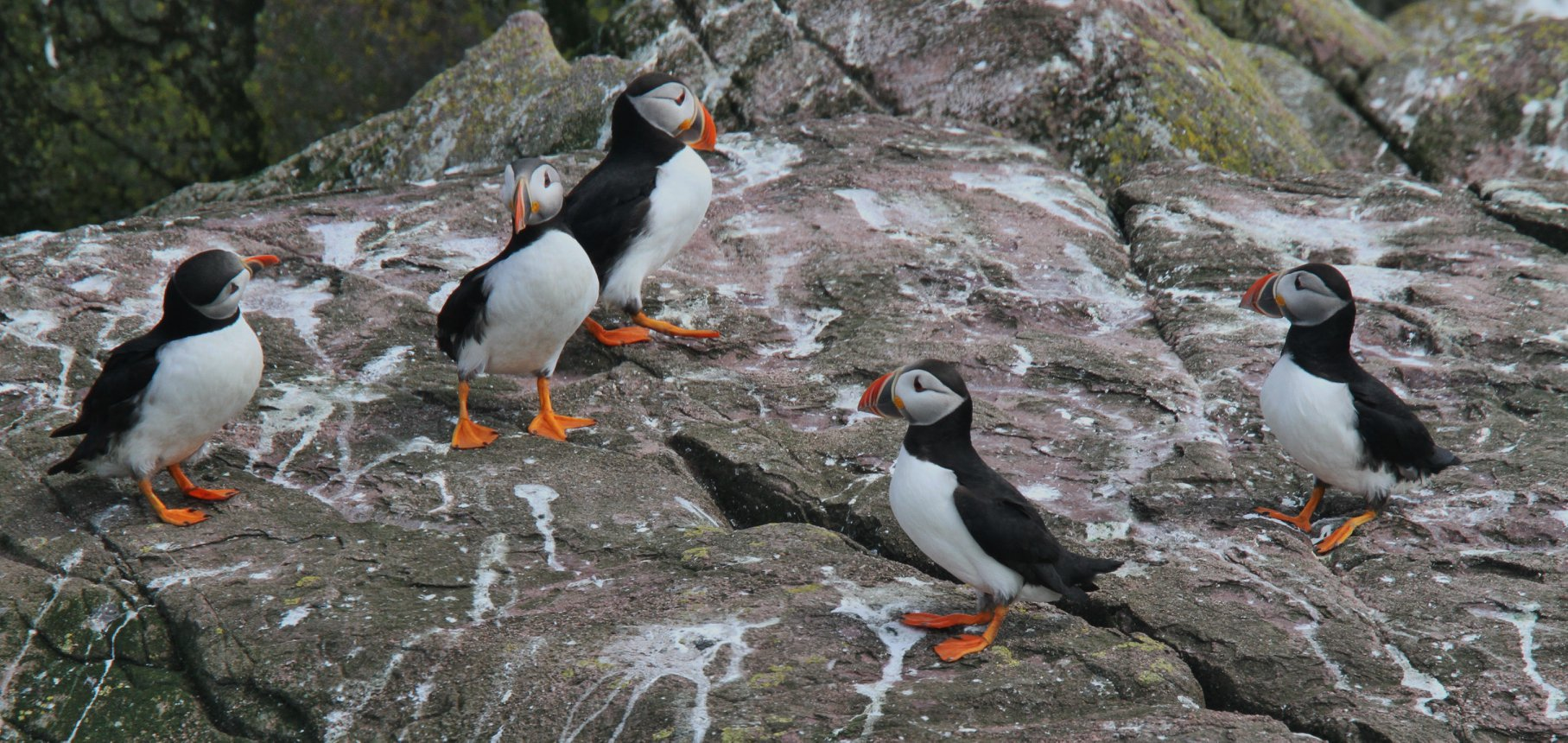 A gathering of Atlantic Puffins
A gathering of Atlantic Puffins
Gannets are common about the southeast Avalon during their long breeding season, regularly flying in formation along the coast. The great splash they make as they dive headfirst into the water after a fish is often mistaken for the blow of a whale. When they are diving for Capelin make sure you stop, go down to the beach and watch. This is truly a seminal birding event that you will see when the Capelin assemble inshore. Given the setting, flocks of Gannets diving is an unforgettable birding event. Great Cormorant is occasionally recorded in summer and is a regular here in fall, winter and spring.
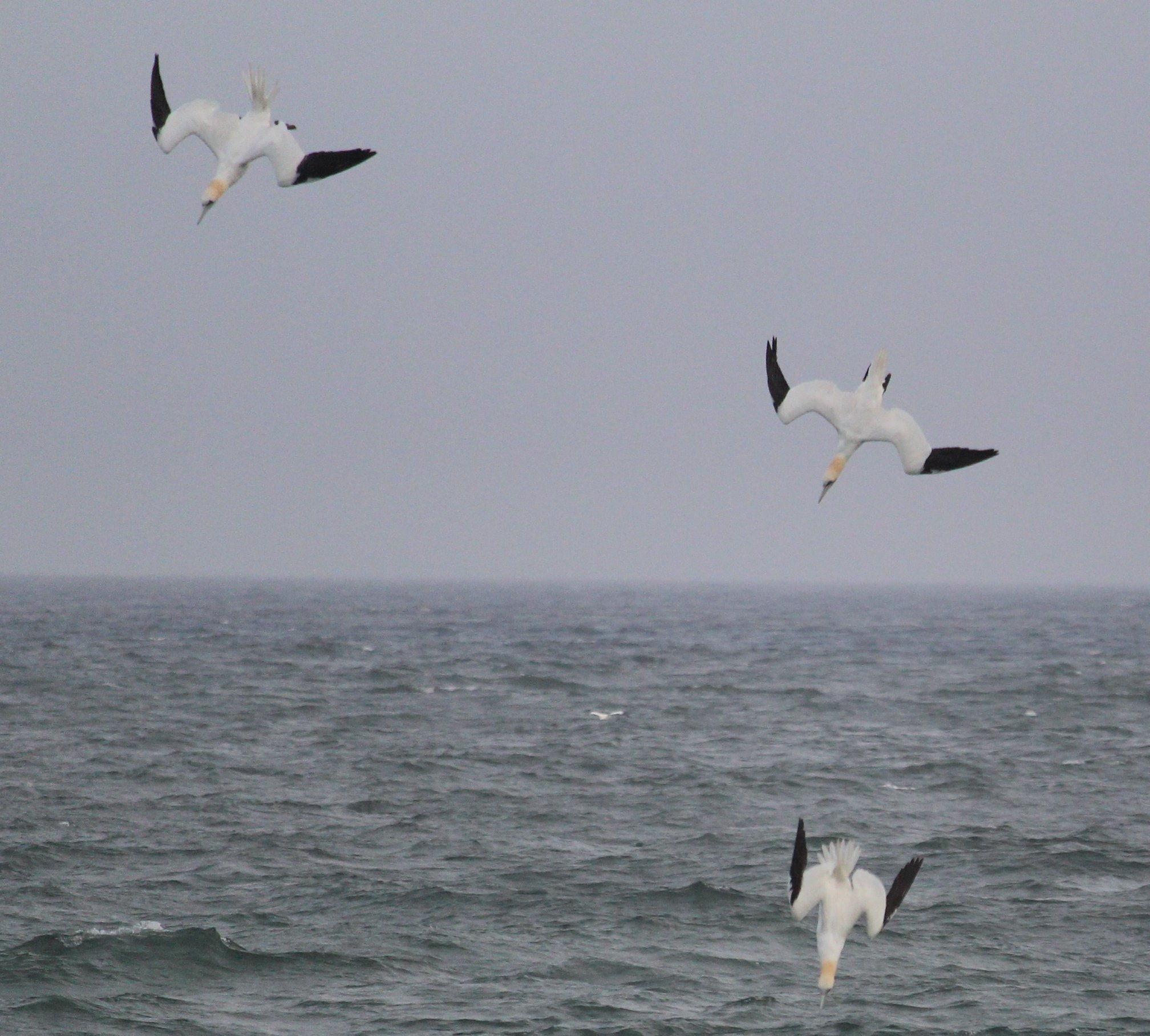 In the photo above Clifford Doran has caught three Gannets in various stages of their dives.
In the photo above Clifford Doran has caught three Gannets in various stages of their dives.
Nesting Land Birds
Visitors from southern Canada, the United States and elsewhere will be delighted to have the opportunity to observe boreal-nesting species, some of which they see briefly in migration, in their habitats. With diligence visitors can find in a few days stay Greater Scaup, Willow Ptarmigan, Greater Yellowlegs, Black-backed Woodpecker, Canada Jay, American Pipit, Pine Grosbeak and Blackpoll and Wilson’s Warblers, and others. For more details see the “Annotated List of Breeding Land Birds”.
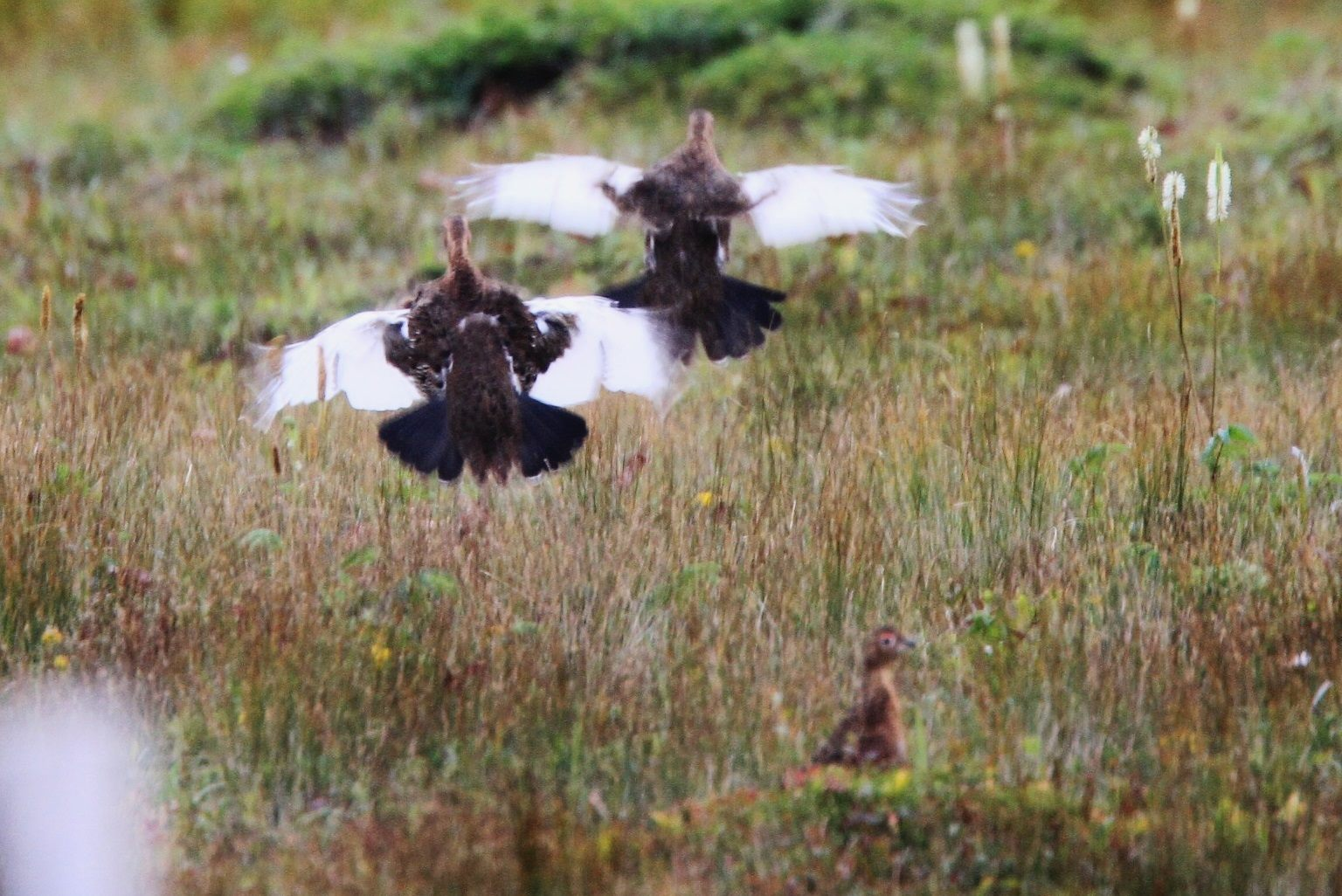 Part of a family group of Willow Ptarmigan
Part of a family group of Willow Ptarmigan
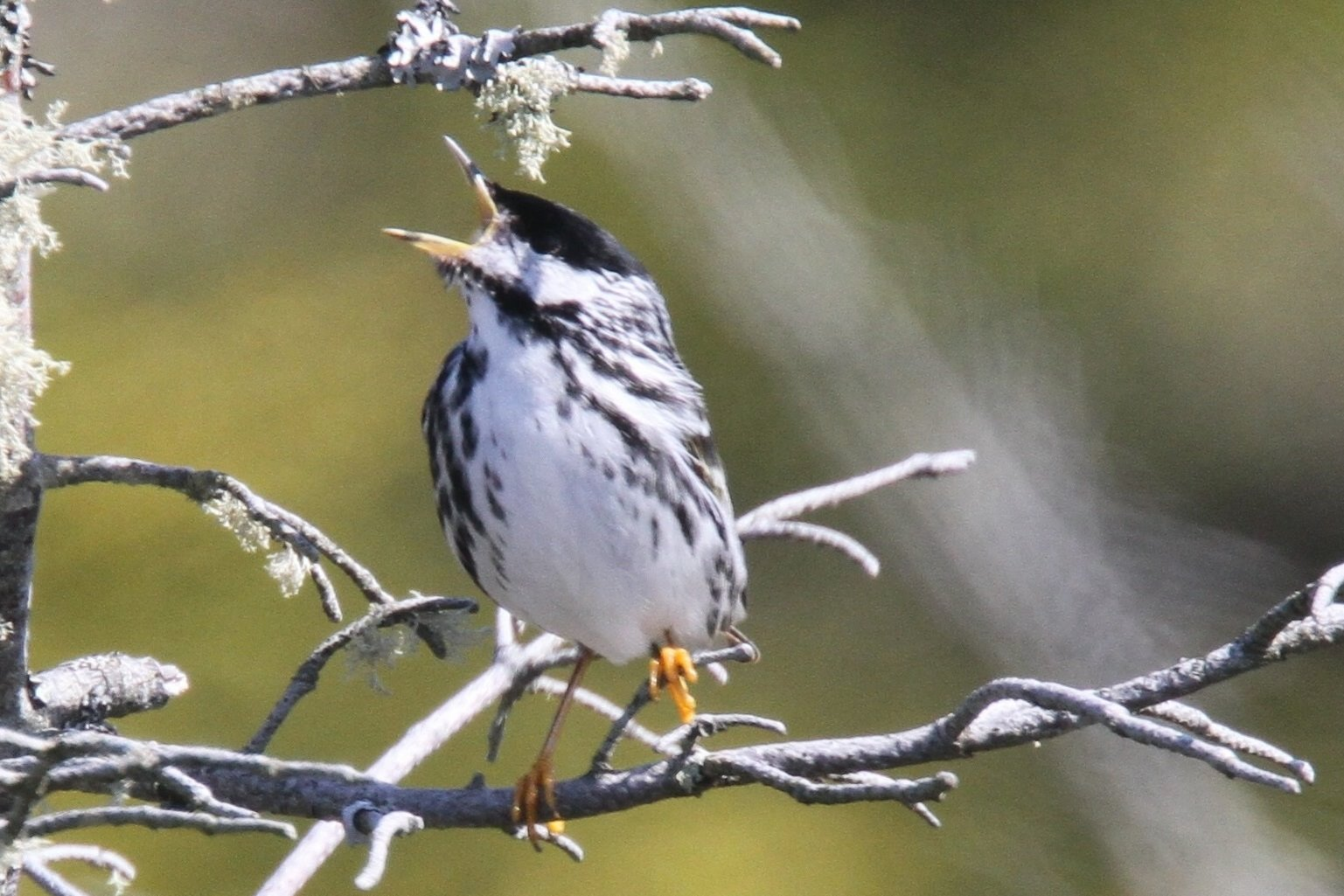 This singing male Blackpoll Warbler is one of the most common local breeding warblers
This singing male Blackpoll Warbler is one of the most common local breeding warblers
Summer Gull and Tern Movement
Arctic Gull species are generally quite rare in summer. Very uncommon single immature Little Gulls are the most likely. Rare and irregular in early summer is the Bonaparte’s Gull. The Sabine’s Gull is also rare and occasionally recorded from late June and July into late summer.
Both the Black-headed and Lesser Black-backed Gulls, neither of which currently nest in our area are increasingly recorded throughout the summer and fall. By far the most common vagrant gull from the Atlantic coast is the Laughing Gull which in recent years is regularly reported throughout the summer. Perhaps the most interesting is the excellent variety of Atlantic terns that are very irregularly reported from mid- June through July including Least, Gull-billed, Black, Roseate, Sandwich and Royal Terns.
The Pelagic Migrant Main Event
In summer millions of Sooty and Great Shearwaters migrate to the far North Atlantic from their southern hemisphere breeding grounds, passing by the southeast Avalon. This annual invasion starts in mid-June and heats up by mid-July, peaking in late July to mid-August and extending into September. This spectacular migration, a highlight of the Avalon birding year, is best seen from south coast viewing sites such as St. Shott’s fog horn station, Cape Pine lighthouse, Powle’s Head lighthouse, the harbour at Portugal Cove South (PCS) and on the Cape Race Road; Daley’s Cove, the Rookery, Long Beach, and Cape Race. All these sites offer excellent viewing, depending on caplin stocks but traditionally PCS beach is probably the most consistent. Shearwaters can also be seen at Cappahayden, Bear Cove and at the Bear Cove Point lighthouse in Renews.
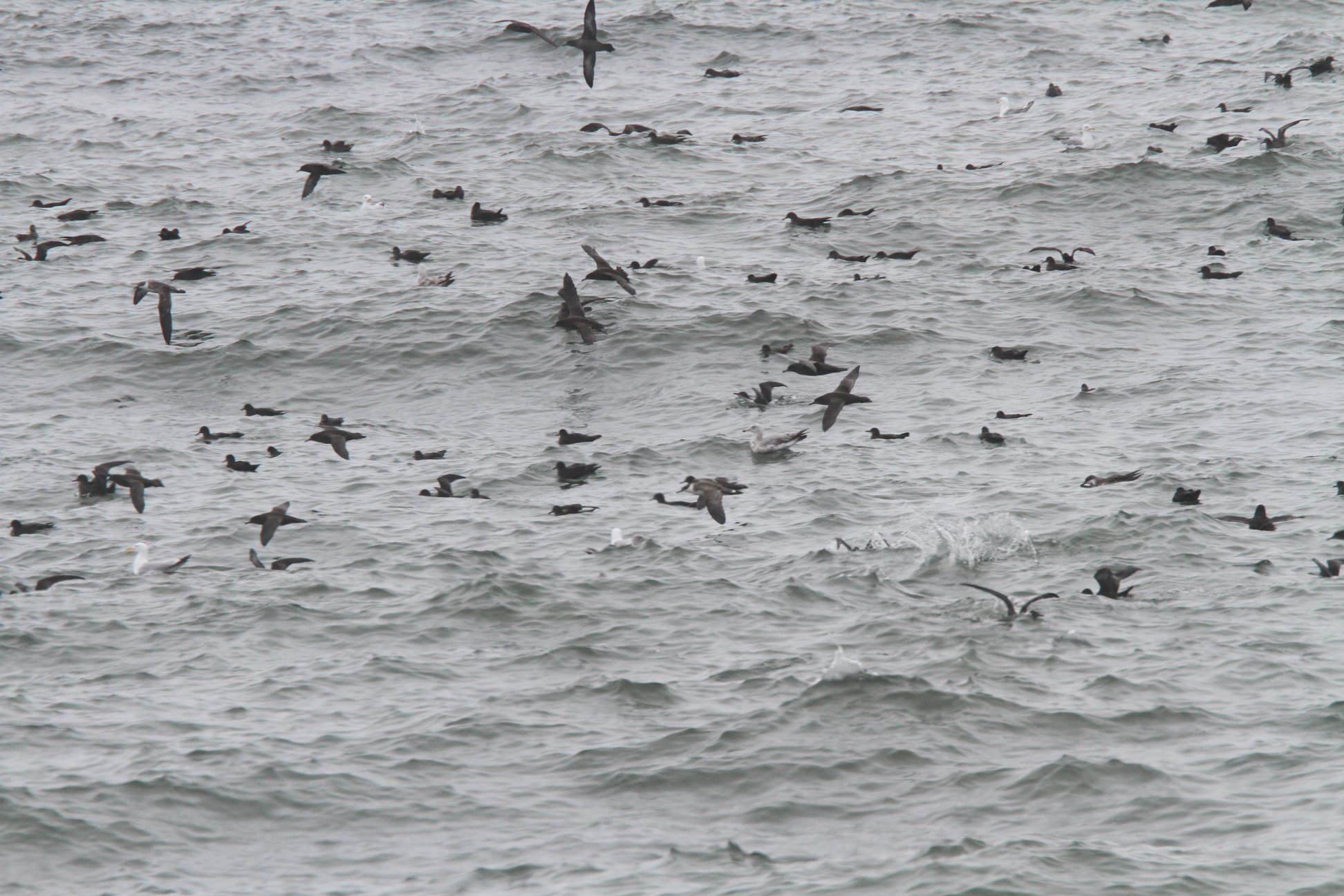 Above Sooty and Great Shearwaters assemble to feed on schools of local Capelin
Above Sooty and Great Shearwaters assemble to feed on schools of local Capelin
Interspersed amongst the shearwaters, which often number in many thousands, a few Manx Shearwaters will be found. They breed on Lawn Island to the west, off the Burin Peninsula. Manx are fairly easy to pick out from the other shearwaters as they are noticeably smaller, uniformly brownish on top and white underneath. A scope and some patience is a definite asset to pick out the occasional Manx!
In July, August and into September look for South Polar Skuas which like the jaegers, sometimes come inshore to harass the shearwaters. Their prime period co-incides with the prime shearwater time, late July and early August. After mid-September skuas, encountered inshore, are much more likely to be Great Skuas, a European species. Great caution is required in separating these two species, since on the rare occasions they are encountered, they are often at distance and viewing conditions are not always ideal.
Fulmars nest on the south side of Ship Island in the Witless Bay Ecological Reserve viewable with a scope from the mail boxes at St. Michael’s, just south of Tors Cove. Fulmars very occasionally stray south to be recorded at Cape Race and Long Beach in July.
A major colony of Leach’s Storm-Petrels nest on Gull Island in the Witless Bay Ecological Reserve. Storm-petrels only visit their nesting burrows at night, a survival strategy as these tiny birds are an attractive meal for the larger gulls (as are Dovekies in winter). Like the phalaropes, they usually forage at great distance from land. Sometimes in foggy summer weather small flocks become disoriented and settle on south coast barachois ponds and harbours. In recent years flocks of 15 to 20 birds have been reported at Holyrood Pond, St Vincents, lower Trepassey Harbour, and the barachois ponds at Biscay Bay and Portugal Cove South. The phalaropes are discussed under late summer.
Other early summer pelagics are rarely seen from shore. The most likely is the Wilson's Storm-petrel This species breeds in Antarctic and sub-Antarctic Islands and like the Sooty and Great Shearwaters migrates north in summer. It is very similar to the Leach’s. As a result the few records are scattered over the summer from July and August and occasionally into September. This off-shore species is rarely recorded inshore except during or after storm periods. On the other hand, since single Leachs inshore in daytime is very rare too, so carefully examine any storm-petrels you see for flight pattern, tail shape and toe extension beyond tail.
Gulf Stream Waters and the Brown Booby
The Brown Booby, while not strictly a pelagic species, is appearing more frequently in southern Newfoundland waters. Its local presence in summer was first noted in 2015 at Long Beach in early August. In recent years this species has been recorded more frequently along the southern coast of Newfoundland. Its presence is thought to be the result of the intrusion of warmer Gulf Stream waters. Another exciting Gulf Stream bird is the Cory’s Shearwater which is now being seen more regularly from late July. Cory’s is discussed under late summer.
Eurasian Vagrants
European vagrants are usually recorded during the spring and fall migrations or in early winter. Early summer records are so uncommon that when they are recorded one can expect an extreme rarity such as the case of a single Common Swift in July at Cape Race. The few other early summer records consist of a single record for Redshank (July 10), Ruff (4 records between July 4 and early Sept), Common Gull in late June and in July, a Yellow-legged Gull in early August, and two records of Great Skua in July and early August.
Early Arctic Shorebirds
Spotted and Least Sandpipers and Greater Yellowlegs are the shorebirds which nest in our area. In early summer adult shorebirds start to arrive from their arctic habitats. Usually the first is the Whimbrel in early July followed in mid-month by Semipalmated Plover and Lesser Yellowlegs, and Black bellied Plover by about July 20th. By early August Short-billed Dowitchers, Turnstones and White-rumps are present on local beaches.
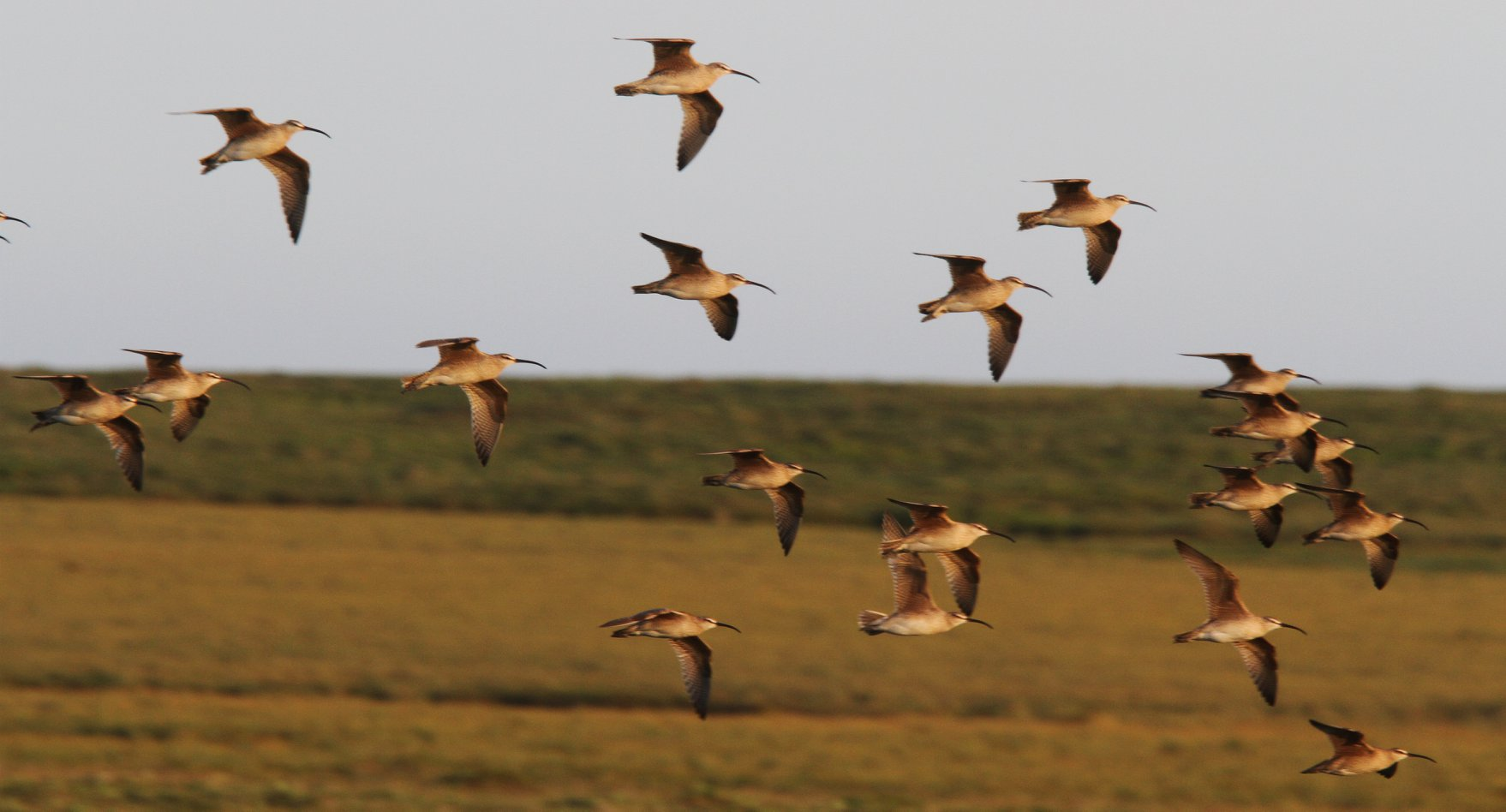 A flock of Whimbrel landing on the Cape Race barrens
A flock of Whimbrel landing on the Cape Race barrens
A major feature of shorebirding at this time is the regular appearance of single adult Common Ringed Plovers on south coast beaches from early August into September. This bird, which normally nests on Baffin Island and Greenland, and migrates east through Europe, is now being looked for and more regularly found in summer among flocks of Semipalmated Plovers. Mid-August also sees the first arrival of spectacular flocks of American Golden Plovers on the Cape Race Road barrens.
Arctic Jaeger Migration
Most of the Jaegers recorded in early summer are difficult-to-identify immature Pomarine and Parasitic Jaegers. These are likely non-breeding birds which generally remain offshore but occasionally venture inshore to prey on shearwaters and local gulls and terns feeding on Capelin. Scattered amongst these birds are a few immature Long-tailed Jaegers. The height of the jaeger event co-incides with the maximum concentration of shearwaters from mid July and early August. At this time adult jaegers of all three species are occasionally recorded. Most adults may be the first of the breeding birds from the arctic but the very few adults recorded earlier may be non-breeders.
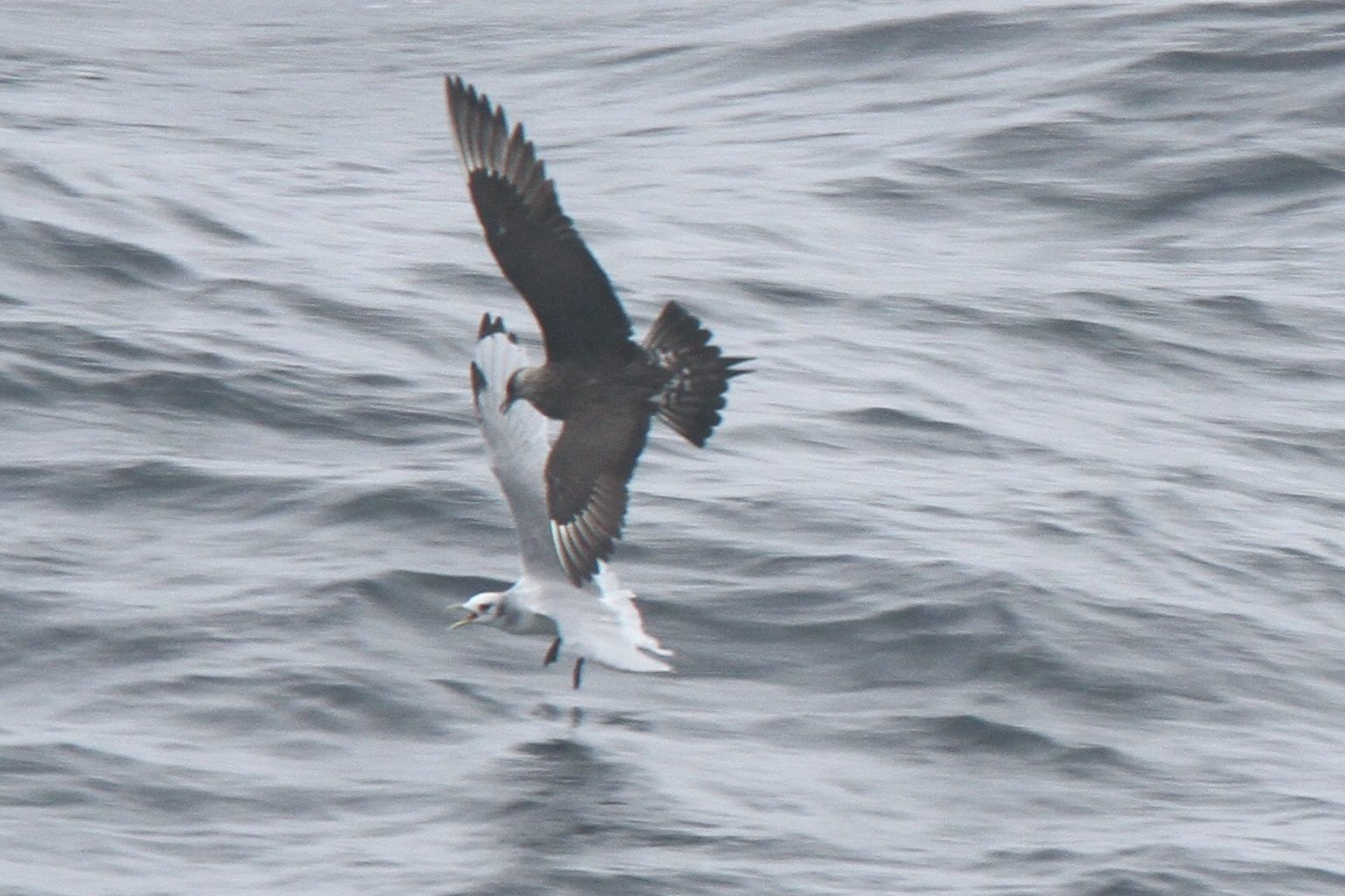 A Parasitic Jaeger harassing a juvenile Kittiwake
A Parasitic Jaeger harassing a juvenile Kittiwake
Gyrfalcon in Summer
We finish discussing the birds of early summer with the gyrfalcon. One of the most bizarre records of arctic birds in early summer is the sighting of a brown phase Gyrfalcon on the St. Shotts road June 28-30, 2019. This may well have been the brown phase gyr recorded at Cape Pine in March. Where it might have been in between is anyone’s guess.
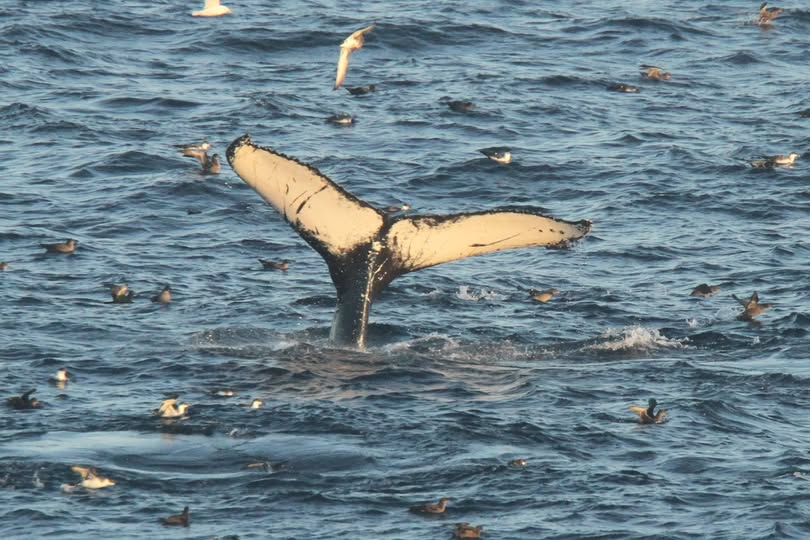 Humpback Whale deep diving for Capelin with assembled shearwaters and gulls
Humpback Whale deep diving for Capelin with assembled shearwaters and gulls
Late Summer: August 16 to September 20
From late August into the fall a great variety of passerines which nest in central and western Newfoundland, supplemented by a few from the Maritimes and eastern Canada, pass through the area. These birds, largely vireos and warblers, are primarily of interest to Avalon birders. Late summer is also the beginning of a small raptor migration. The pelagic migration tapers off during this period at a time when arctic shorebird migration heightens. Vagrants can be found from western Canada, Europe and the Atlantic flyway.
Highlights
- Sooty, Great, Manx and Cory’s Shearwaters
- American Golden-Plover, Ringed Plover and Buff-breasted Sandpiper
- Red and Red-necked Phalarope
- Cape Race Hawk Migration
- Swallow migration
- Rare southern warblers
- Rare European vagrants
- Prairie Warbler
- Lark Sparrow
- Dickcissel
Local Nesting Land Birds
Visitors from southern Canada, the United States and elsewhere will be delighted to have the opportunity to observe boreal-nesting species, which they see briefly in migration, in their habitats. With diligence visitors can find in a few days stay Greater Scaup, Willow Ptarmigan, Greater Yellowlegs, Black-backed Woodpecker, Canada Jay, American Pipit, Pine Grosbeak and Blackpoll and Wilson’s Warblers, and others. For more details see the “Annotated List of Breeding Land Birds”.
Regional Newfoundland and Mainland Canada Migrants
From late August into the fall a great variety of passerines which nest in central and western Newfoundland, supplemented by a few from the Maritimes and eastern Canada, pass through the area. These birds are mainly flycatchers, vireos, swallows, warblers and blackbirds.
The Yellow-bellied Flycatcher remains through the late summer. It is the only regularly-nesting flycatcher in the area. During the month of September the Eastern Kingbird is a fairly regular migrant through the area with a particular fondness for the Bear Cove area. The most common vireo at this time is the Red-eyed which tends to show up in late August and recorded regularly in September. By mid-September a few Philadelphia and Warbling Vireos from western parts of the island and the Maritimes are recorded. The only nuthatch found on the Avalon is the Red-breasted Nuthatch. The main migration through the area appears to be in late August. The Tree Swallow, a late migrant, is the only regular nesting swallow. In late summer a few other species pass through mostly Bank (late Aug to early Sept), Barn (mid-Sept into Oct) and Cliff Swallow (early Sept into Oct).
Late summer is the prime time to record warblers in migration. Listed below are 20 Newfoundland and Atlantic Canada species and their average migration time. Local Breeding Warblers:
Magnolia Warbler (late Aug to mid-Sept), Tennessee Warbler (late Aug to early Oct), Northern Waterthrush (Sept), Mourning Warbler (Sept), American Redstart (Sept),Yellow Warbler (Sept), Blackpoll (Sept), Black and White Warbler (Sept to Oct 5), Northern Yellowthroat (Sept to mid-Oct) and Yellow-rumped Warbler (Sept to Nov 15)
Newfoundland and Atlantic Canada Warblers
Bay-breasted Warbler (late Aug to Sept 20), Palm Warbler (late Aug to Oct 10), Cape May Warbler (early to mid-Sept), Chestnut-sided Warbler (early Sept to Sept 21), Blackburnian Warbler (Sept), Black-throated Green Warbler (Sept to mid-Oct), Nashville Warbler (early Sept through Oct) and Northern Parula (mid-Sept to Oct 20)
Two species which highlight warbler migration patterns are particularly interesting:
Canada Warbler (late Aug to Sept 20)
The Canada Warbler nests in the Maritimes but not in Newfoundland. It is an early migrant more likely to be recorded in late summer. Its presence in the southeast Avalon offers conclusive proof that some mainland passerines occasionally migrate east to Newfoundland instead of directly south to the United States.
Prairie Warbler: (Sept 15 to Oct 20)
The Prairie Warbler does not nest in Newfoundland or Atlantic Canada. Despite this fact each year multiple records of single birds are recorded in the south Avalon in late summer and into the fall. They can be found in the spruces interspersed among alders or in the tuc on the Cape Race Road at Thimble and Cripple Cove. The sighting of this bird, not particularly common anywhere in eastern Canada, is a delightful surprise to local and visitor alike. There are many other uncommon warblers encountered in the late summer and fall each year, but in many ways the Prairie Warbler is a symbol of what makes passerine birding in the southeast Avalon special.
Blackbird Status in the Southeast Avalon
It is surprising to many who visit our area that both the Red-winged Blackbird and the Rusty Blackbird do not breed here. The Red-wing is a casual visitor in late summer and fall. The Rusty for the most part seems to by-pass the area during its spring and fall migrations making it a very uncommon bird here. On the other hand the Bobolink, probably a migrant from Atlantic Canada, is often recorded in late August or early September.
Pelagic Migrants
While the height of the shearwater season starts to decline from early to mid-August a large number of Great and Sooty Shearwaters remain in the area, along with a few Manx, until the end of the month and into September. The shearwater season has been greatly enhanced in late summer by the explosion of Cory’s Shearwaters in late August, September and into October. This event is thought to be due to the presence of preferred food in warmer Gulf Stream waters extending east along the south coast. The presence of Corys will enhance the pelagic birding season which starts in July by extending it into October.
In recent years an increasing number of single Brown Boobies, a coastal-based seabird found in warmer waters, are being recorded in southern Newfoundland waters in September. The increasing likelihood of recording Corys and Brown Booby going forward in late summer and into fall offer one more reason, along with the most reliable pattern of good weather on the south coast, to consider visiting the area at this time.
The occasional record of Wilson's Storm-petrel continues into late summer. The remarkable sighting of 12, recorded from St. Shotts fog horn site on September 5, 2022, is not untypical of how idiosyncratic and exciting local birding can be.
Late Summer Arctic Shorebird Migration
A major feature of shore birding at this time is the flocks of American Golden Plovers which usually arrive by mid-August. Their regular presence is a wonderful addition to the flocks of Whimbrel on the barrens. They are best found along the Cape Race Road east of the Bristol Cove trailhead. Single Buff-breasted Sandpipers are very occasionally spotted in the flocks of Golden Plover but more likely on southern coastal beaches from late August into September.
Of great interest to North American birders is the regular appearance of single Common Ringed Plovers on southern shore coastal beaches from Trepassey east to Long Beach. Ringed Plover, which normally nests on Baffin Island and Greenland, and migrates east through Europe, is now being looked for, and more regularly found, in late summer among flocks of Semipalmated Plovers. The main migratory period for easier to identify adults is from early August to early September, followed by juveniles in September. A late fall bird was found on PCS beach on November 30.
Phalaropes in migration are a feature of late summer birding in the area. Red-necked Phalaropes are usually recorded in small flocks within a confined period from August 20 to early September. Red Phalaropes usually show up about the same time but records indicate that they remain in the area into late September. On August 23, 2008 a massive total of 4,000 Red Phalaropes were recorded off the south coast headlands from St. Shotts to Cape Race. This incredible event seems to have been brought about by massive concentrations of micro-organisms, likely krill, in the tide line off coastal headlands and beaches. Birders should always check the incoming tide line at this time for these tiny birds easily missed in the vast ocean landscape.
Arctic nesting shorebirds such as Whimbrel, Short-billed Dowitcher, Red Knot and Least Sandpiper, which have lingered in the area, have mostly departed by mid-September. Uncommon but regular late summer shorebirds of interest recorded in harbours and beaches include Hudsonian Godwit (Sept 10 to Oct 10), Stilt (Aug 25 to Sept 15), Bairds (Aug 30 to Sept 20), Pectoral (Sept 1 to Oct 20) and Semipalmated Sandpiper (Aug 10 to Sept 20).
Cape Race Road Hawk Migration
The southern Avalon experiences a raptor migration which commences in late summer and extends into the fall. The origin of some of these hawks may be from the north Avalon. Since there are occasionally non-Avalon breeding species recorded these birds must migrate east and then follow the coastline south to Cape Race before turning west along the south coast.
This migration is noticeable about mid-August and consists of a few Ospreys, Sharp-shinned Hawks, Goshawks and Harriers. By mid-September the volume of these species peaks and is joined by American Kestrels. On September 19, 2011 a Swainson’s Hawk was reported from Bear Cove Point Renews, and later in the day from Cape Race. The presence of this non-breeding Newfoundland bird suggests that some hawks seen here might originate from the mainland, crossing over to the island by the Strait of Belle Isle. The Cape Race hawk migration spills over into the early fall period. The recognition of this migration was first promoted by David Shepherd who lived for many years in PCS. Swallow Migration
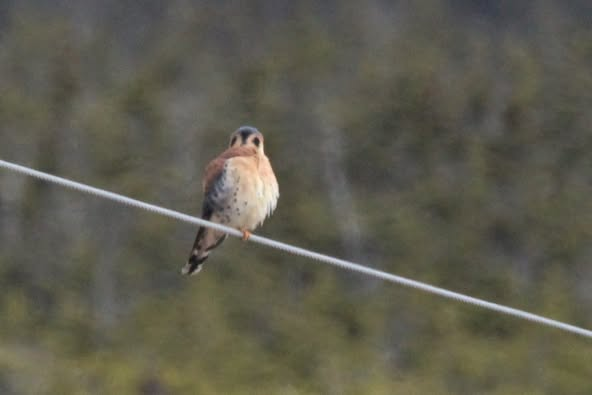 American Kestrel, which does not nest in our area, is a regular feature of the south coast hawk migration
American Kestrel, which does not nest in our area, is a regular feature of the south coast hawk migration
The Tree Swallow is the only local nesting swallow. There are a few records for Barn Swallow but overall most swallow encountered are migrants. The other swallows most likely to be encountered are: Bank Swallow (mid July to mid-Sept), Purple Martin (Sept 10 to 20) and Cliff Swallow (from mid-Sept)
Migrants from Western Canada
It is not always easy to determine where migrant species with wide breeding ranges might have originated. The two species recorded which sometimes nest from western Ontario west to the prairies are not problematic. In the late summer Lark Sparrow (month of Sept) and Dickcissel (from mid-Sept to late fall) are regular vagrants seen often enough to be sought out in appropriate habitats. These birds are known to be brought in by the prevailing easterly flowing winds of late summer to end up here instead of central and northern South America. Much less frequently an occasional Yellow-headed Blackbird or other blackbirds can be found in the large flocks of Starlings which assemble on the south coast after the breeding season.
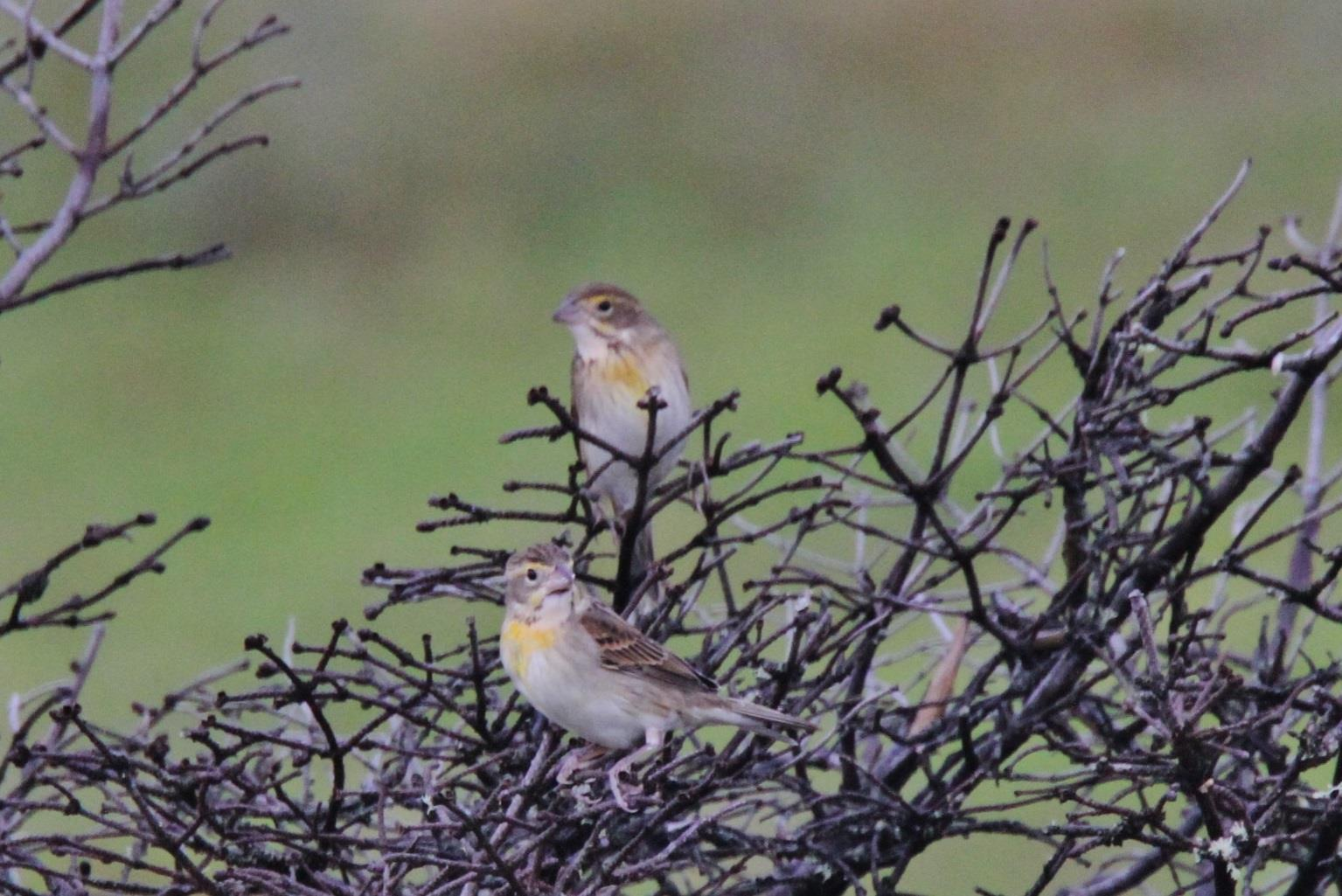 Dickcissels in Cliff Coran’s “patch” behind the lightkeepers’ house at Cape Race.
Dickcissels in Cliff Coran’s “patch” behind the lightkeepers’ house at Cape Race.
Atlantic Flyway Vagrants
With the exception of Canadian west coast vagrants, almost all the rarer passerines recorded here were south-bound migrants blown off course by tropical storms, the remnants of hurricanes, disorientation, or reverse migration. Some may have bred as far north as southern Canada but most probably in the central of southern United States. Most are very desirable warblers including Yellow-breasted Chat (including one that stayed long enough to be recorded on the Cape Race Christmas Bird Count) and rare warblers such as Golden-winged, Worm-eating and Yellow-throated Warbler.
From late August into October the tropical storm vagrants are flycatchers, cuckoos, vireos, warblers, Almost all of these passerines breed in the southern and central United States. These birds are night migrants, and the lighthouses at Cape Pine, Powell’s Head in Trepassey, Cape Race, and Bear Cove Point in Renews are key to attracting these birds to landfall. For a more detailed discussion of this topic check out “The Importance of Lighthouses”
It must be emphasized that while the list of tropical-bound fall migrants shown in our Checklist is surprising, perhaps astounding for remote southeastern Newfoundland, observations vary from year to year. Indeed the vagrant list in any year is hugely dependent on two key factors:
- the number and intensity of post tropical storms which pass by the Avalon peninsula;
- the number of dedicated birders who look for them.
The following relatively rare species which mostly breed in more southern latitudes in the United States are to be looked for locally. These species are arranged into two categories: regular vagrant, and vagrant or accidental. These categories are defined as follows:
- RV = Regular vagrant; does not nest on Avalon but recorded most years
- V = Vagrant: 6 or more records; pattern too frequent to be accidental
- A = Accidental: no expectation of occurrence, 5 records or less
Regular Vagrants
- Yellow-breasted Chat (Sept 15 to Oct 15)
- Prothonotary Warbler (mid-Aug to late Sept)
- Kentucky Warbler (early Sept to early Oct)
- Hooded Warbler (early Sept to mid-Oct)
- Blue-winged Warbler (early Sept to mid-Oct)
- Orchard and Baltimore Oriole
Vagrants and Accidentals
- Yellow-throated Vireo (mid-Sept to late Oct)
- Cerulean Warbler (early to mid-Sept)
- Golden-winged Warbler (early to late Sept)
- Blue-gray Gnatcatcher (early Sept to mid Oct)
- Yellow-throated Warbler (early -Sept to mid-Nov)
- Worm-eating Warbler (mid-Sept and early Oct)
- Connecticut Warbler (mid-Sept to early Oct)
- Yellow-headed Blackbird
European Vagrants
European vagrants are usually looked for during their spring and fall migration seasons. Strong prevailing winds are likely a big factor in their reaching landfall to the northwest Atlantic. Some fall vagrants linger into early winter. Other late fall-early winter records may be European vagrants that landed earlier in other parts of Newfoundland, Atlantic Canada or the northeastern United States. Wandering about, looking for a way home, they eventually find their way eastward to our area, the farthest east they can go on the North American continent.
Like the early summer records, the few European species that are recorded at this time tend to be extreme rarities. These include two records of Great Skua (late August and September), and single records for juvenile Little Stint (mid-September), White Wagtail (mid-September) and Redwing (August 24).
A Note on Rare Birds in the Southeast Avalon
It is very important to point out that the discovery of the presence and the subsequent identification of birds like the Little Stint, and other difficult-to-identify rarities, requires regular coverage and birders with talent, experience and exceptional observational skills to identify them. In most areas of North America where there are a lot more birders, key birding areas are much better covered by birders of all skill sets
On the Avalon there are a limited number of birders. Almost all live in the St. John’s area. Complete coverage of he southeast Avalon is not really possible on a day trip. The end product is often a hastily conducted trip to the better spots in the better seasons on the days when the weather is most favourable.
The inevitable result is that some rarities like White Wagtail and Redwing will be found if they are encountered. Others like Little Stint are more likely to be passed over. Whether easy or hard to identify the reality is that the list of rarities on the Southeast Avalon Checklist is inevitably a major under representation of the real vagrant record. There are very few places in North America like it. Richard Thomas is the only birder living on the south coast. His discovery of a Greater Sand Plover at Biscay Bay on April 12, 2025 points yet again to the unique birding presented by our area. This record, and the exceptional record of the Pacific Loon at Daleys Cove in February, 2025, are the only inclusions beyond the 2024, the last year that bird records have been used to assemble this website.
Fall: September 21 to December 20
The advancement of fall brings significant changes to the bird life of the southeast Avalon. As with the other seasons, the dynamics is best explained by dividing the time frame into early fall (September 21 to October 31) and late fall (November 1 to December 20). As noted elsewhere this separation of boundaries work for most but not all species.
Early Fall: September 21 to October 31
On the Avalon we see the departure of most of the thrushes, sparrows, and warblers. During this period many of the Avalon breeding ducks and geese depart. Of the alcids, Atlantic Puffins and Common Murre numbers start to decline as many move offshore. Most breeding landbirds such as Yellow-belled Flycatcher, Robin, Hermit Thrush, Grey Catbird, White-throat, Swamp, Savannah and Fox Sparrows have departed by the end of October.
Migrants also pass through from central and western Newfoundland, the mainland and much further afield, including the arctic, and vagrants from Europe, western Canada and the United States.
Highlights
- Vagrants from Atlantic Canada, western Canada, southern US and Europe,
- Arctic migrants
- Cape Race Road hawk migration
Newfoundland and Mainland Canada Migrants and Vagrants
Listed below are Newfoundland, Maritimes and eastern Canadian species most likely to be recorded in early fall and their average migration dates arranged in checklist order and main departure time. For relative commonness refer to the Checklist.
- Great Crested Flycatcher (late Sept and Oct)
- Red-eyed Vireo (early Sept to Oct 20)
- Warbling Vireo (late Sept to mid Oct )
- Philadelphia Vireo (late Sept and Oct)
- Blue-headed Vireo (Oct and November)
- Chipping Sparrow (late Aug to late fall)
- Nelson’s Sparrow (mid-Oct into Nov)
- Lincoln’s Sparrow (late Sept into Nov)
- Tennessee Warbler (late Aug to early Oct)
- Palm Warbler (late Aug to Oct 10)
- Northern Waterthrush, American Redstart, Mourning, Blackburnian, Yellow
- and Blackpoll Warbler (all to the end of Sept),
- Black and White Warbler (Sept to early Oct)
- Northern Yellowthroat and Black-throated Green Warbler (Sept to mid-Oct)
- Nashville Warbler (early Sept through Oct)
- Prairie Warbler (mid-Sept to Oct 10)
- Northern Parula (mid-Sept to Oct 20)
- Black-throated Blue Warbler (late Sept and Oct)
- Pine Warbler (late Sept to early Nov)
- Yellow-rumped Warbler (Sept, Oct to Nov 15)
- Orange-crowned Warbler (Oct and Nov)
- Scarlet Tanager (month of Oct)
- Rose-breasted Grosbeak (mid-Sept and Oct)
- Indigo Bunting (Sept 20 through Nov)
- Grasshopper Sparrow (late October to early December)
A variety of passerines which nest primarily in western Newfoundland, pass through the area in the early fall. These birds, including Warbling and Philadelphia Vireo, Northern Parula, Palm and Nashville which are generally widespread in the Maritimes and eastern Canada are primarily of interest to Avalon birders. The Pine and Black-throated Blue Warbler which nest in the Maritimes, but not in Newfoundland, are very uncommon migrants that occasionally recorded in the fall.
Western Canada Vagrants
Prevailing winds sweeping east across central and eastern Canada bring regular vagrants such as Lark Sparrow mostly recorded in the month of September but occasionally into early November. A third sparrow to be looked for is the Clay-coloured Sparrow from early October to mid-November. The Townsend's Warbler has been recorded from October 15 to early December. The Dickcissel is the most regular western species recorded in small numbers throughout fall.
Atlantic Flyway Vagrants
With the exception of vagrants from mainland Canada, almost all the rarer passerines recorded locally are south-bound migrants blown off course by tropical storms, the remnants of hurricanes or disorientation or reverse migration.
The following relatively rare species, which mostly breed in more southern latitudes in the United States and winter in central America and south, are found in the early fall period. Some of the late summer migrants are repeated here. We have broken down the records into two categories: regular vagrants and vagrants and accidentals. Some recorded in late summer and fall may have different status based on the number of records for the period.
Regular Vagrants
- Yelow-billed Cuckoo (Sept 20 to Oct 15)
- White-eyed Vireo (late Sept through Oct).
- Yellow-breasted Chat (late Aug, Sept and Oct)
- Blue Grosbeak (mid Sept through Oct)
Vagrants and Accidentals
- White-winged Dove (late Sept, Oct and Nov)
- Black-billed Cuckoo (mid to late Sept)
- Yellow-throated Vireo (late Sept to early Oct)
- Prothonotary Warbler (mid-Aug to late Sept)
- Kentucky Warbler (early Sept to early Oct)
- Hooded Warbler (early Sept to mid-Oct)
- Worm-eating Warbler (mid-Sept to early Oct)
- Connecticut Warbler (mid-Sept to early Oct)
- Blue-winged Warbler (mid-Sept to mid-Oct)
- Yellow-throated Warbler (mid-Sept to mid-Nov)
- Summer Tanager (mostly Oct into Nov)
Single records exist in mid-October different years for King Rail and Clapper Rail, Fork-tailed Flycatcher (early to mid-Oct)
European Vagrants
The list of European vagrants that show up in fall is long, headed by the Wheatear which can be looked for in coastal areas between October 5th and November 5th. Early fall is an excellent time to look for rare vagrant European shorebirds: Lapwing, Eurasian Golden-Plover, Wood Sandpiper and Curlew Sandpiper. Other species perhaps even rarer include Tufted Duck straying from the St. John’s area and Corn Crake. Please consult the Checklist for details.
Arctic Migrants
By about the middle of October the first of the arctic breeding waterfowl arrive such as the Long-tailed Duck, Red-throated Loon and Horned and Red-necked Grebe. Arctic nesting shorebirds that migrated into the area and lingered, that leave from late September, (listed by average departure date) include Buff-breasted Sandpiper (Sept 30) Red Phalarope (early Oct), Hudsonian Godwit (Oct 10), Lesser and Greater Yellowlegs (mid-Oct), Black-bellied Plover and Pectoral Sandpiper (Oct 20), American Golden-Plover, Semipalmated Plover and Sanderling (Oct 31). Breeding migrants and non-breeding sub-adult Pomarine and Parasitic Jaegers have usually departed the area by the end of October. By mid-October the first of the wintering flocks of Snow Buntings and a few Lapland Longspurs have usually arrived.
Cape Race Road Hawk Migration
The southern Avalon experiences a raptor migration which commences in late summer and extends into the fall. From late September until the end of October this migration peaks although it is very erratic. It is dominated by the same species recorded in late summer. The species most frequently seen and average final departure dates are as follows: Osprey (Sept 21), Sharp-shinned Hawk (October 1), Harrier, Merlin and Peregrine (October 15). Goshawk and Rough-legged Hawk are also recorded. Their migration extends into November.
During this period almost all the exceptional raptor sightings have been recorded including Golden Eagle (October 8), Swainson’s Hawk (October 11), Gyrfalcon (October 15) and Red-tailed Hawk (October 23). The actual importance of this raptor migration is largely unknown due to low numbers and the very irregular presence of birders to observe them.
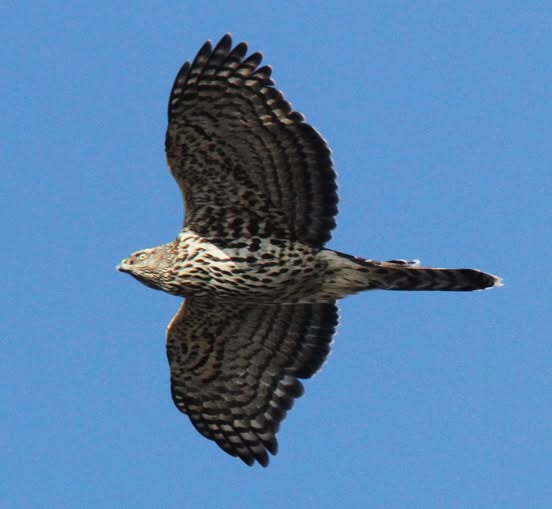 Immature Goshawk in migration on the Cape Race Road
Immature Goshawk in migration on the Cape Race Road
Late Fall: November 1 to December 20
In late fall, from early November to December 20 sees a few late records for land and seabird migrants. Other bird records come from all four directions, dominated by the arrival of the wintering arctic species but also a smattering of vagrants from western Canada, the Atlantic flyway and Europe.
Highlights
- Arrival of high arctic wintering species: King Eider, Dovekie and Purple Sandpiper
- Vagrants from western Canada: Townsend’s Warbler and Western Kingbird
- Atlantic flyway vagrants: White-winged Dove
- European vagrants: Northern Lapwing
Regional Newfoundland and Mainland Canada Migrants
By early November most of the breeding migrant passerine land birds and breeding seabirds have left the area. Migrant species such as shorebirds, gulls that remain into late fall and dates of departure are as follows:
- Sanderling (late Oct and November)
- Dunlin (late Nov)
- Black-head Gull (throughout)
With the local breeding migrants largely gone, the regular presence of resident populations of boreal species such as Willow Ptarmigan, Black-backed Woodpecker, Canada Jay, Boreal Chickadee, Pine Grosbeak, Purple Finch and Red and White-winged Crossbills become a more important part of the birding season.
High Arctic Migrants
The descent of severe winter weather in the arctic forces the migration of many species south to the more temperate land and sea conditions of the southeast Avalon. At this time loons, grebes and ducks pass through the area some stay on to spend the winter locally. A good indication of the species that enter and stay in our area can be seen by examining the Cape Race Christmas Count database. Arrival of species takes place from late October into December as follows:
- Common Eider, Red-breasted Merganser (early Nov)
- Horned and Red-necked Grebe (mid-Nov)
- Purple Sandpiper (Nov 20)
- Glaucous Gull, Iceland Gull (early Nov)
- Harlequin Duck, Thick-billed Murre (mid Nov)
- Snowy Owl (mid-Nov)
- Redpoll (mid-Nov)
- American Tree Sparrow (early Nov)
- King Eider (early Dec)
Western Canada Vagrants
In fall each year prevailing easterly winds sweep across Canada to the Avalon. These winds tend to bring in a small but regular infusion of birds normally found in eastern North America, and occasionally even in western North America. While the Lark Sparrow disappears from the scene the Dickcissel can be found into early winter.
Townsend’s Warbler, more normally associated with the west coast of North America, is found most years in the St. John’s area in late fall. After an incidental observation in 1998 at Bear Cove, Townsend’s Warbler has been recorded five times since 2012 in late fall at Renews, and in recent years in northwest Trepassey. Western Kingbird, (mid-Oct into Nov) occurs with some frequency at this time as the Checklist shows. Accidentals such as Eared Grebe, Varied Thrush and Golden-crowned Sparrow have also been recorded.
Atlantic Flyway Vagrants
In fall an eclectic mix of birds from the Atlantic coast migration linger from early to late fall, including:
- White-winged Dove (late Sept into Nov)
- Yellow-throated Warbler (mid-Sept to mid-Nov)
- Summer Tanager (mostly Oct into Nov)
On rare occasions extreme vagarants turn up in southeast Avalon including
- Cave Swallow (November 8, 2013 at Long Beach)
European Vagrants
The Lapwing is the most likely vagrant to be encountered with the earliest record of November 7th. There are also three records each for Corn Crake (late Sept to early Nov) and Curlew Sandpiper (Oct-Nov) and a single record for Wood Sandpiper (November 11, 1998).
Winter: December 21 to March 20
Winters on the south east Avalon tend to be much milder than in the St. John’s area. This results in precipitation falling as rain instead of snow. It can also be windy.
Summary of Cape Race Christmas Bird Count Results: 1977-2024
One of the best ways to get a snapshot of winter birding in the southeast Avalon is to examine the summary data from the Cape Race Christmas Bird Count. A map of the Count circle is set out below.
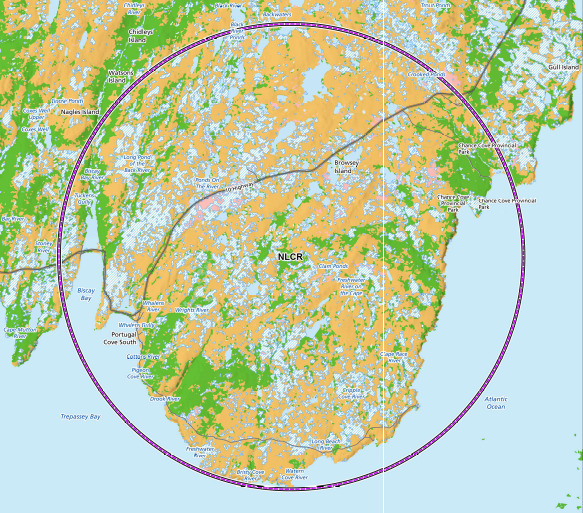 The Audubon Society Cape Race Christmas Count Circle showing access roads, barrens in orange and forest areas in green.
The Audubon Society Cape Race Christmas Count Circle showing access roads, barrens in orange and forest areas in green.
The Count, initiated by naturalist John Maunder in 1977, has been faithfully run for many years by St. John’s ornithologist, Bruce Mactavish. A summary of Count results (1977-2024), which includes the number of years observed and high counts for each species is available in this section. The complete 41 year data set, which includes 134 species, has been used in the analysis set out below. Due to occasionally poor weather conditions, or rarely for lack of enough participants, the count has not been conducted 7 times. The data, which includes the 2024 Count, represents the successful completion of 41 counts. Count results have been incorporated into the larger Checklist.
Count results invariably depend on climatic conditions and coverage each year. Overall the data set is adversely affected by inclusion or otherwise of results from Chance Cove Provincial Park. This Park is the most important heavily-forested boreal habitat in the Count area. Access and coverage in the Park in winter can be affected by snow conditions and whether there are enough birders to cover it. Reduced or lack of coverage will impact the volume and variety of seabirds and passerines in years when this situation occurs. This variable has not been assessed and results in general conclusions about bird populations from this key 41 year data set.
It is also important to note that data is not available from the Renews area which falls within the circle of the Ferryland Christmas bird count. No count is conducted in the Trepassey area, and further west on the St. Shotts barrens, Cape Pine, St Shotts, Peters River and St. Vincents. To some extent this lack of coverage at Renews and Trepassey in particular has been addressed by examining the records from eBird and nf.birds.
Limitations of Winter Coverage of the Southeast Avalon Area:
Three factors which limit the analysis of winter birding:
- Occasional exclusion of Chance Cove Provincial Park,
- Exclusion of Renews CBC data
- No CBC coverage of Trepassey
In addition, virtually all the most active Avalon birders live in the St. John’s area. Due to less vagrancy, often less than ideal winter driving conditions, the distance involved, and the reduced daylight hours, regional birders do not visit the area with the same frequency as other seasons. Historically there have been six or seven bird feeders in the area. Lack of bird feeders reduces the chances that stray woodpeckers and passerines will be recorded. In recent years there are only three or four active feeders.
Overall the lack of a long-term systematic winter data set from the two key birding areas, Renews #3 and Trepassey #4 birding spots in the province seriously affects our understanding of the southeast Avalon birding in the winter season.
With all these caveats, the long-term data set of the Cape Race Christmas Bird Count provides the most accurate record on what one might expect on a winter visit.
Unlike the discussion of the other three seasons winter birding in the southeast Avalon is not broken down into sub-seasons. Throughout the winter period bird populations tend to be a bit more stable due to less migratory movement which reduces vagrancy.
Winter Highlights
- Large populations of Common Eiders and a few King Eiders
- Small populations of Harlequin Ducks
- Flocks of White-winged Scoters which occasionally contain a few Surf and Blacks
- The presence of Willow Ptarmigan, Canada Jay, and other resident species
- Flocks of Purple Sandpipers and occasionally other shorebirds
- Small flocks of Dovekies and Black Guillemots and occasionally other acids
- Iceland Gulls in good numbers
- Small numbers of Horned and Red-necked Grebes
- An eclectic mix of vagrants
Residents and Overwintering Arctic Migrants
The opportunity to see ducks and seabirds in the ocean with a backdrop of rocky cliffs, passerines in the boreal forest or in patches of picturesque tuckamore, or white-plumaged ptarmigan in an expansive wind-swept landscape offers many opportunities for outstanding photography.
The coasts are a major wintering area for White-winged Scoters, Common Eiders and Dovekies. Eider flocks very occasionally harbour a King Eider. Scoter flocks regularly hold a few Surf and Black. Purple Sandpipers, sometimes in large flocks, can be found feeding on the rocks at the tide line. Harlequin Ducks and Thick-billed Murres rare in other seasons, are regular in winter in the southern Avalon.
The following interesting exerpt from an article about the local wintering duck species is taken from an on-line site:
Key Site 48: Avalon Peninsula, Cape Spear to St. Shotts, Newfoundland: Sea Duck Key Habitat Sites Atlas Narratives.
Historical data suggest about 75% of the eiders wintering in this area are the northern subspecies (Somateria mollissima borealis) with the remainder being the American subspecies (Somateria mollissima dresseri) and small numbers of King Eiders (Somateria spectabilis); Gilliland and Robertson 2009). This represents about 6% of the continental population of Northern Common Eiders (NAWMP 2012).
During the winter of 1987, a large flock of 12,000 borealis eiders was observed at the edge of pack ice around Mistaken Point, although counts in the 1990s estimated fewer than 1000 eiders (NF024; IBA Canada Website). Up to 1000 King Eiders winter in the area of Witless Bay (Government of Newfoundland and Labrador 1994). Harlequin Ducks (Histrionicus histrionicus) overwinter along the coast at Cape Spear, Cape Race, St. Shott’s, and Black Rocks near Chance Cove (eBird 2020).
Other sea duck species that use [in winter] this area include Surf Scoter (Melanitta perspicillata), Black Scoter (Melanitta americana), White-winged Scoter (Melanitta deglandi), Long-tailed Duck (Clangula hyemalis), Common Goldeneye (Bucephala clangula), Common Merganser (Mergus merganser), and Red-breasted Merganser (Mergus serrator) (eBird 2020)
Some winters Snowy Owls are present. If the breeding season in the arctic is particularly favourable excess birds, often juveniles, are forced south in winter. If lemming populations are down this will also cause owls to migrate south. Under either of these conditions, particularly the former, invasion as possible. If the south Avalon is having a “vole year” owls might remain in large numbers. In the early winter of 2014-15 a total of 301 owls were recorded on one day by Bruce Mactavish between Trepassey and Cape Race. In Snowy Owl invasion years a few sometimes linger on the barrens into the summer. There is no evidence that a pair has ever bred in our area but since Wheatears have found the habitat suitable enough to nest, it is a possibility!
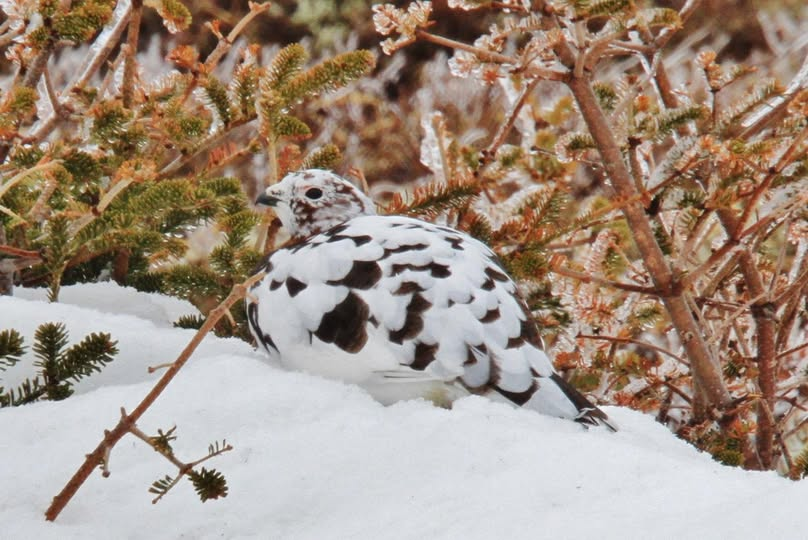 Willow Ptarmigan in its mostly winter plumage
Willow Ptarmigan in its mostly winter plumage
Both Boreal and Saw-whet Owl are most likely to be recorded in winter. The breeding status of both in the area is uncertain. Scant records indicate that the Saw-whet is most likely breeder to be encountered in forested areas such as Daniel’s Point, Trepassey, Biscay Bay or PCS. Two records for Boreal Owl in January and February suggest that it may be a regional migrant.
Ivory Gull and Gyrfalcon are a rare sighting just about anywhere in Canada south of their arctic breeding sites. There are a handful of records for Ivory Gull from late December to early March although the most likely time of occurrence is in the month of January. Ivory Gulls have been recorded from Renews, St Shotts, Trepassey, PCS , Long Beach and Cape Race.
Winter records for Gyrfalcon are fewer, mostly from the south coast. Cape Race is the most likely spot to look. The most curious, but for our unique area, perhaps not so surprising, are 2019 records of a brown phase Gyrfalcon recorded at Cape Pine on April 27th followed by another brown phase gyr, perhaps the same bird, on June 28-30th on the nearby St. Shotts Road. Given our southern landscape so reminiscent of the arctic, and very few birders visiting in winter and early spring, it is possible that the same bird may have remained unrecorded on the south coast during the intervening two months. Given the lack of coverage it is even possible that the bird overwintered.
Vagrants, while fewer in winter, compared to the other seasons, can be particularly random and eclectic.
Arctic Vagrants
A single Brant was recorded in Trepassey Harbour, January 10, 2013. The overwintering presence of a single Pacific Loon for eight years ending in 2020 is an interesting record mostly recorded off St Vincent’s beach east to Peter’s River. Perhaps not so unexpected then is the Pacific Loon which was recorded at Daley’s Cove on February 6, 2025. The high-arctic nesting Yellow-billed Loon which turned up in Trepassey harbour in April, is an extreme example of an arctic winter vagrant.
Vagrants from Western Canada
Fairly regular fall vagrants Dickcissel and Lark Sparrow have usually disappeared by the onset of winter. Recent years has seen three records for Golden-crowned Sparrow from late October to early December but this species has not been encountered in winter. The few records of demonstrably west coast birds are Varied Thrush, January 4, 2006 at Renews , Swainson’s Hawk, January 18, 2019, Cape Race Road and five records in recent years for Townsend’s Warbler mostly from the Renews-Cappahayden area and Trepassey. The origin of the few Swainson’s Hawks recorded in Newfoundland is uncertain. Unlike other buteos they tend to wander more. There is some speculation that numerous records in eastern Canada suggest that a small number may breed in remote northern Quebec.
Atlantic Flyway Vagrants
The origin of White-winged Dove seems certain to be southwestern US. One bird overwintered in 2016-17 at Renews. The origin of other species in late fall into early winter remains uncertain but Sora, January 5, 2005 at Renews, Turkey Vulture, January 16, 2020 at Bear Cove and three Grasshopper Sparrow records on the southern shore plus two records on the Cape Race count suggest that all these birds ended up in the area as vagrants from the Atlantic flyway.
European Vagrants
Vagrants from Europe are rare in the winter period. There are 6 Lapwing records in the winter season with the latest January 21st. The Redwing has been recorded three times, all on the southern shore, from late December to early March. Rarer European bird records include a Common Gull from late January through February at Trepassey, and a Common Snipe on January 14, 2023 at PCS. The status of the Common Gull, as the Checklist indicates, suggests its vagrant status may be changing.
The unique Cape Race Christmas Bird Count historical database has been useful in documenting recent bird trends and population dynamics. Historical weather records from Cape Race over 40 years has been compiled by researchers from Concordia University in Montreal, studying the evolution of fish species on the Cape Race barrens. These records show a mean increase in temperature in the winter and spring seasons of 1.5C.
The combination of moderating climate probably most affected by increased ocean temperatures, and by individual natural range extensions, have likely had the largest impacts on changes on overwintering bird-life. While changes to date are not likely statistically measurable, the following treads appear evident:
- Increase in overwintering populations of ducks: American Black Duck, Green-winged Teal, Ring-necked Duck and White-winged Scoter
- Increase in the resident populations of House Sparrows, Goldfinches and Song Sparrows;
- Increase in overwintering populations of Blue Jays, American Pipits and Dark-eyed Juncos;
- Declines in overwintering populations of Horned Larks, Pine Grosbeaks, Evening Grosbeaks and White-throated Sparrows
Forty year climate data for Cape Race indicates that summer and fall temperatures have increased 2C. Further discussion of the possible affects of climate change on seasonal southeast Avalon bird populations will be found elsewhere on this site.
